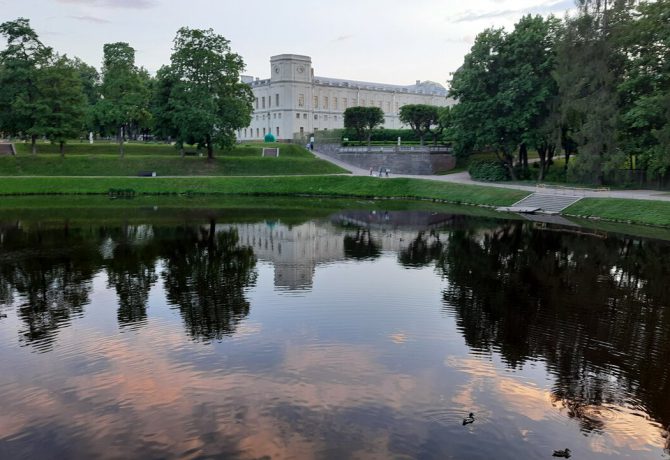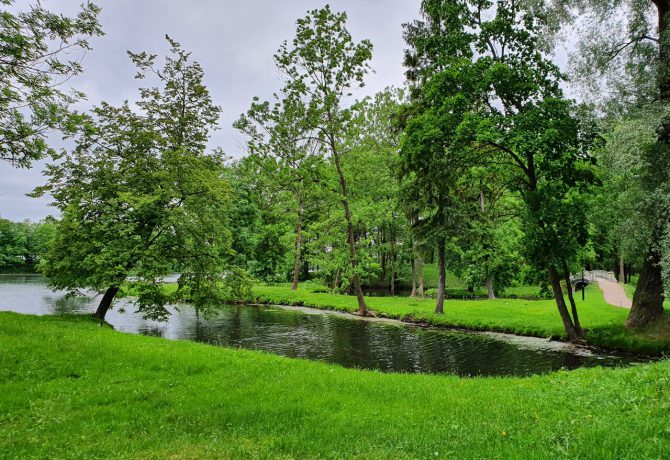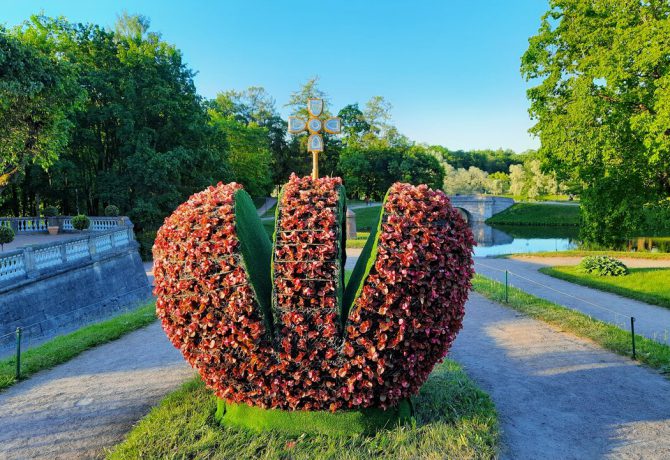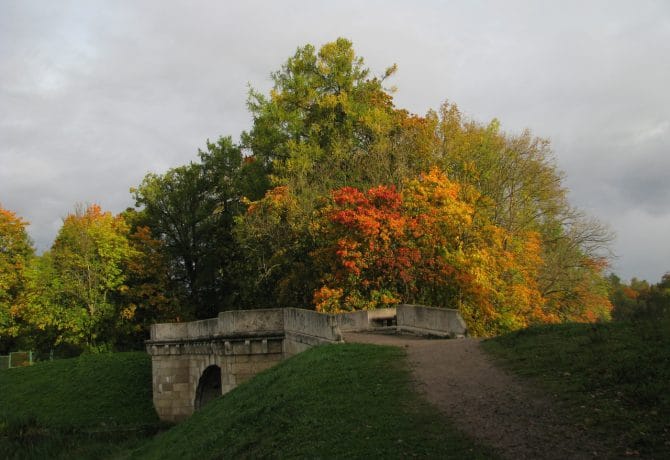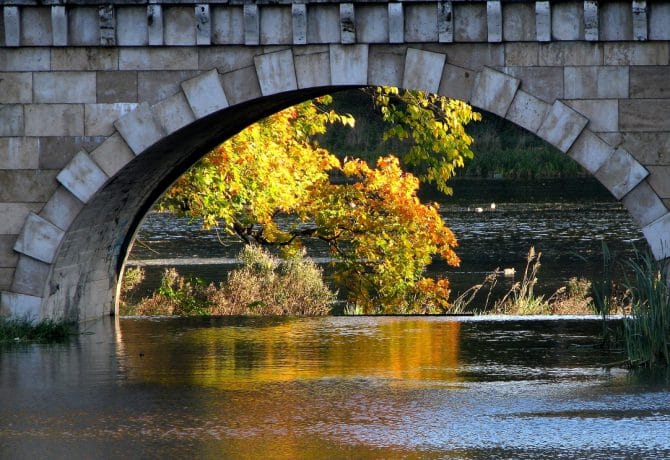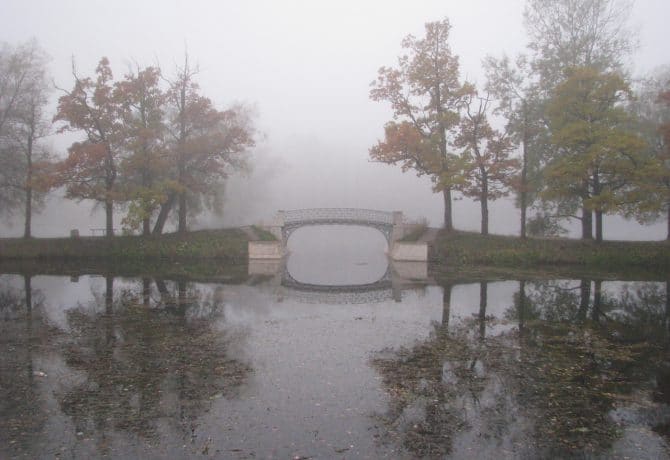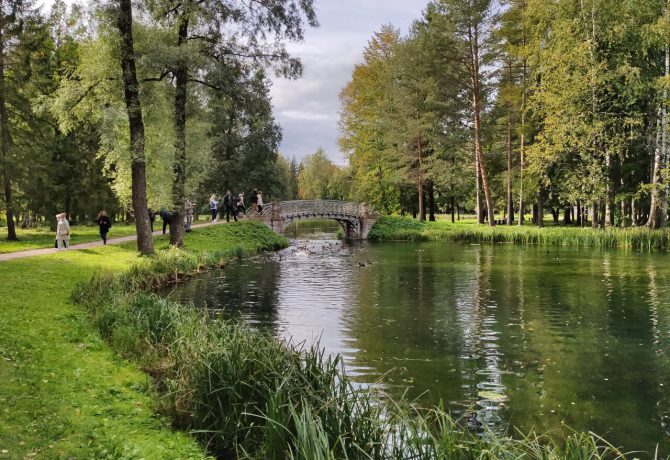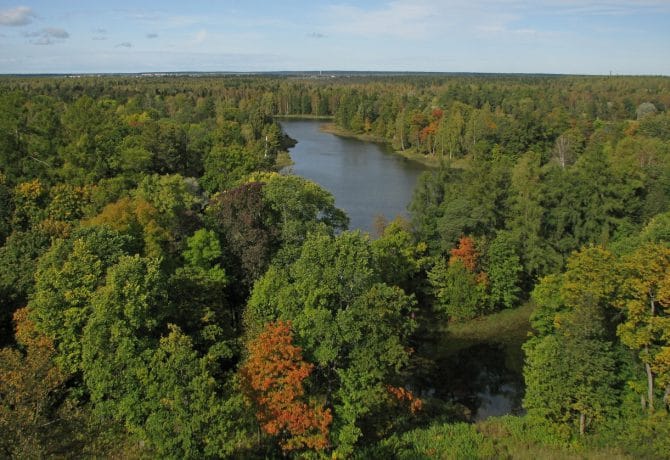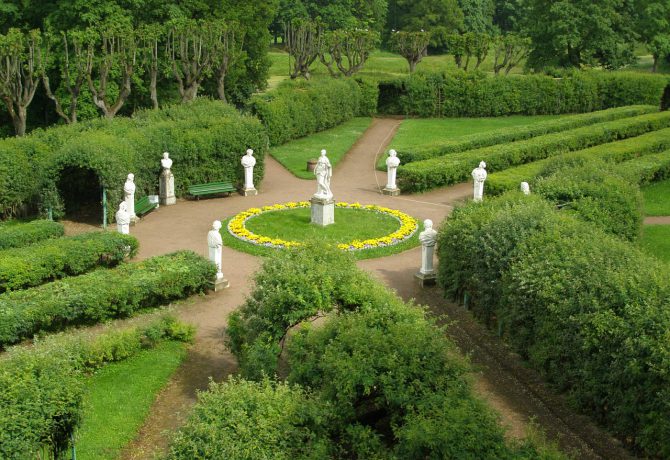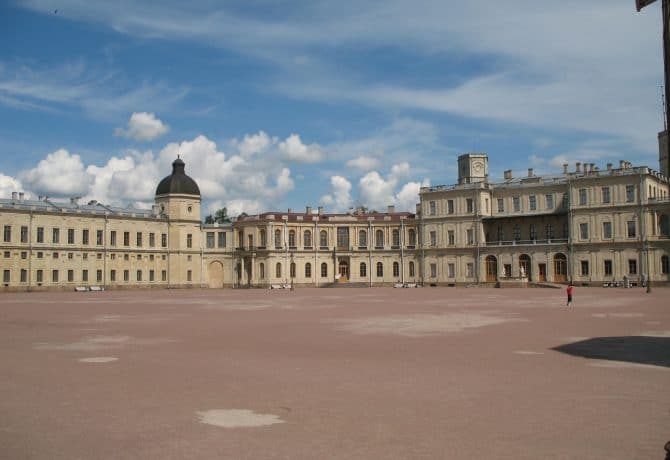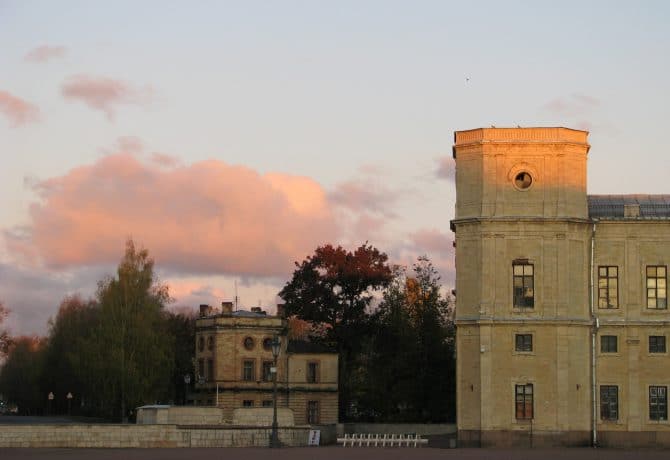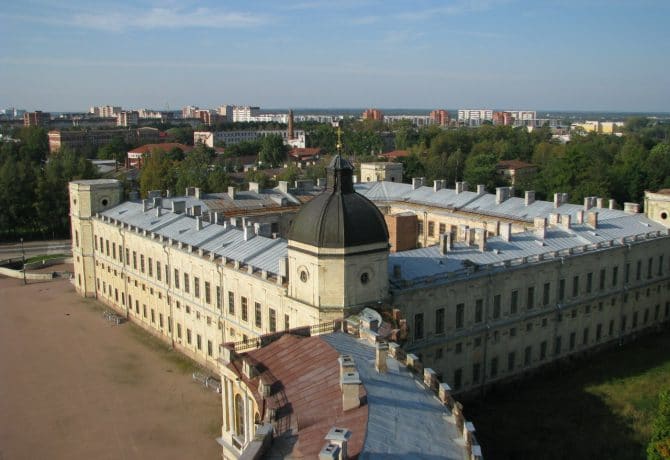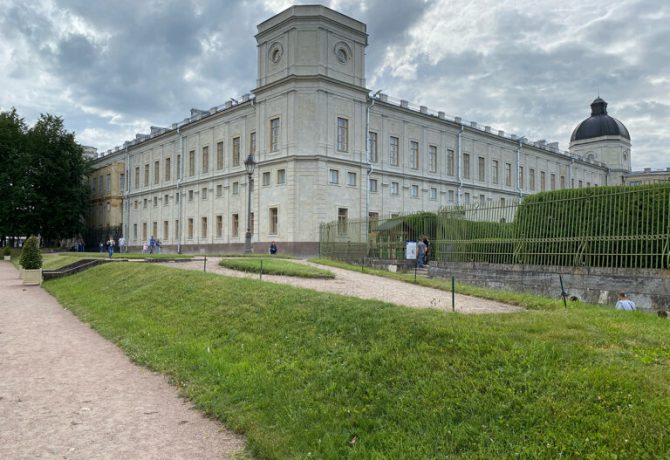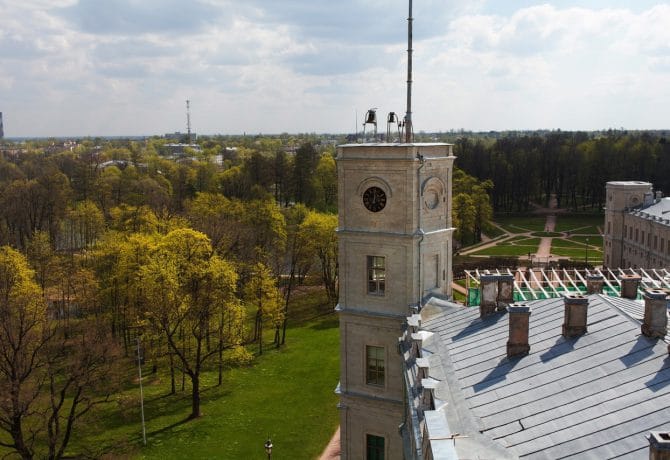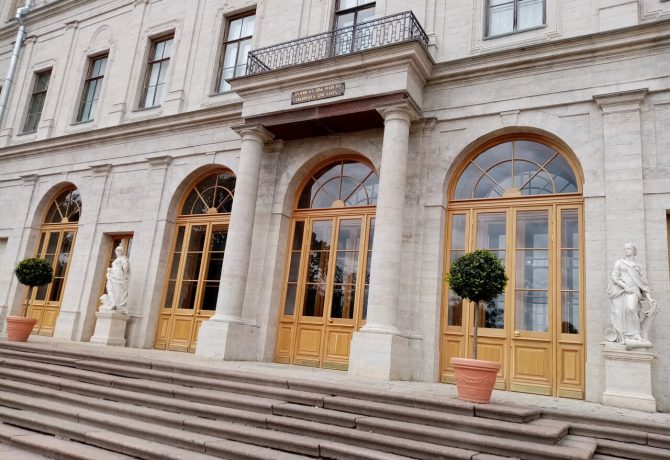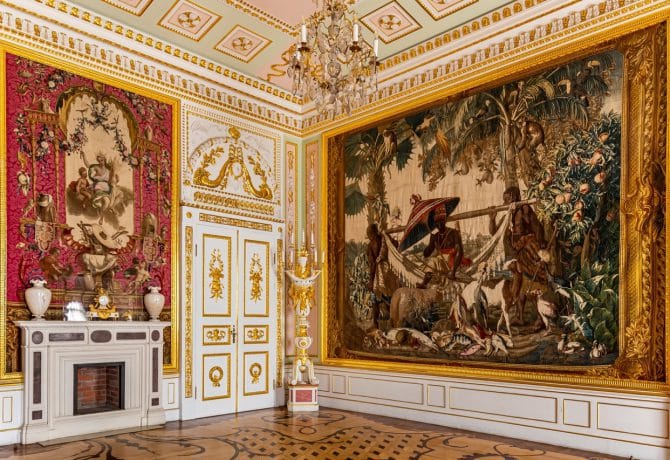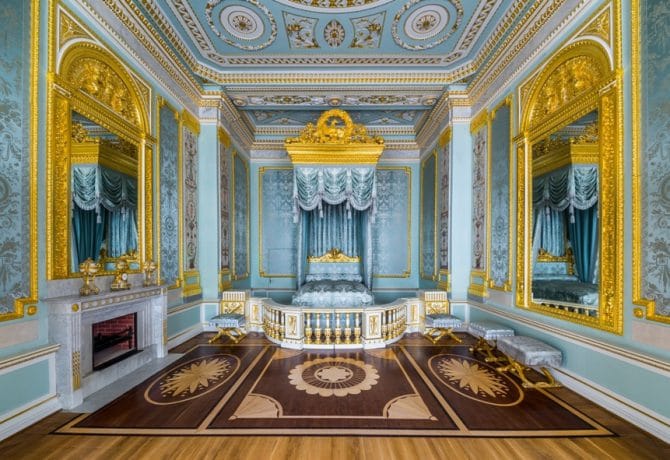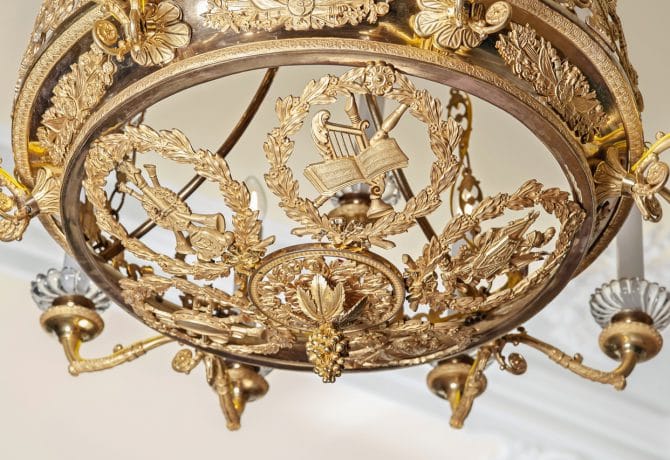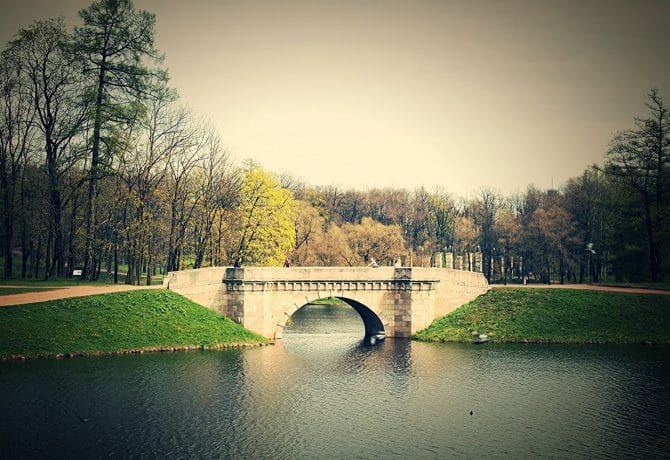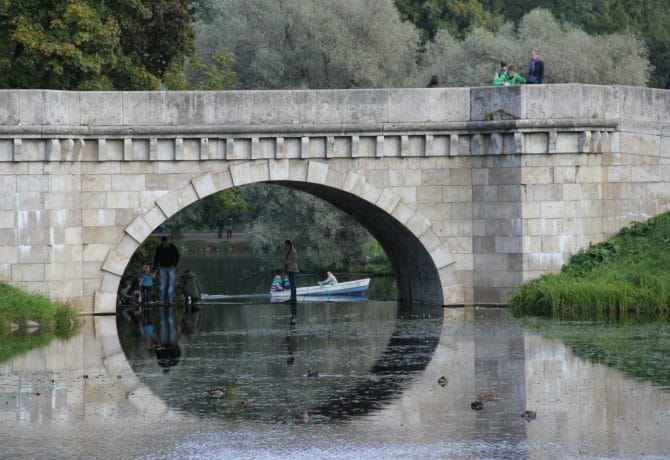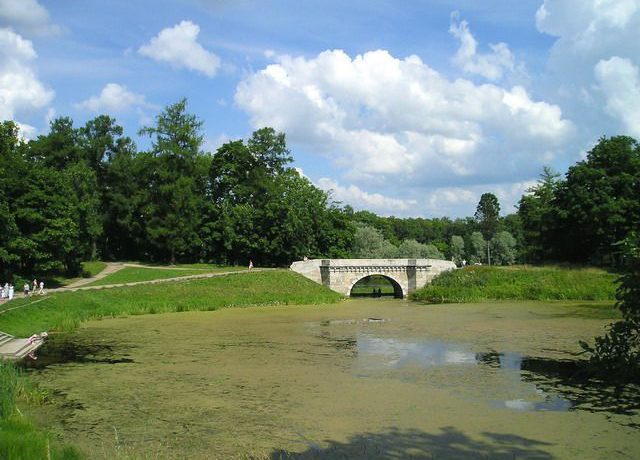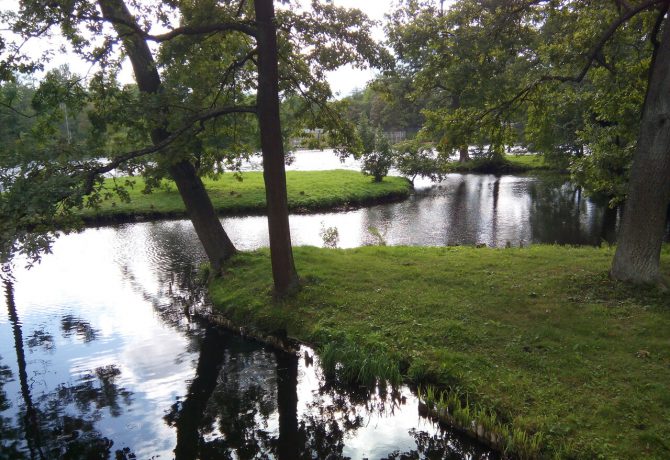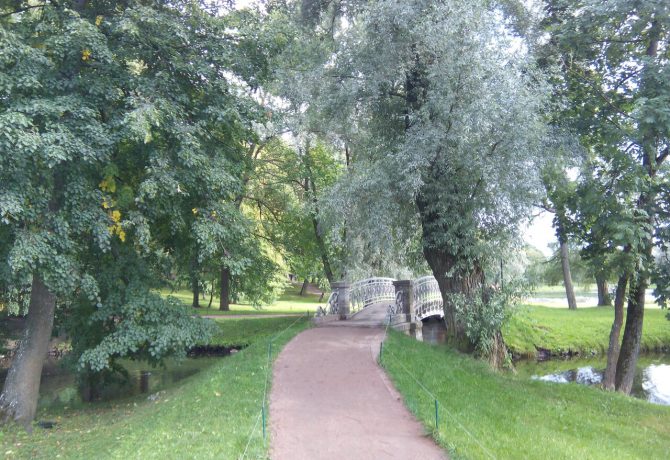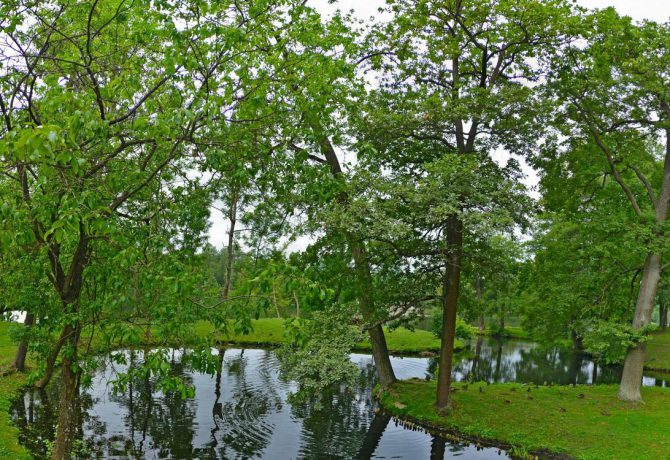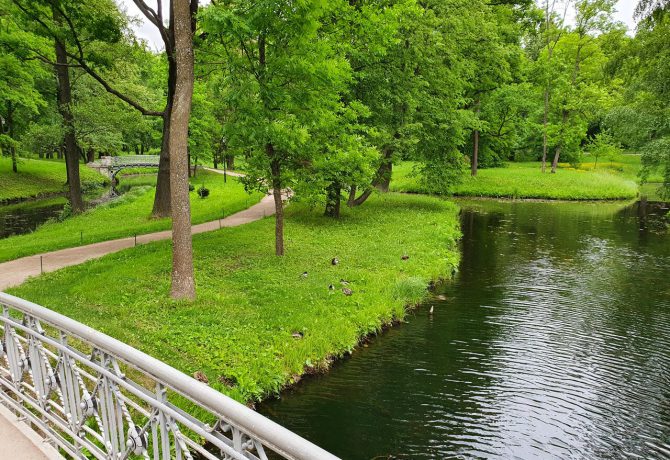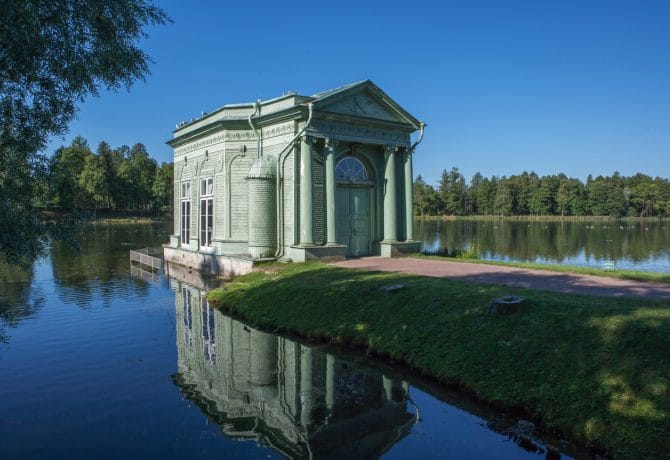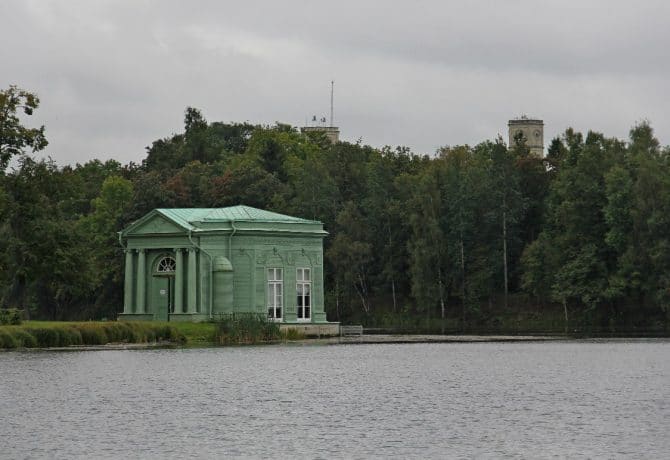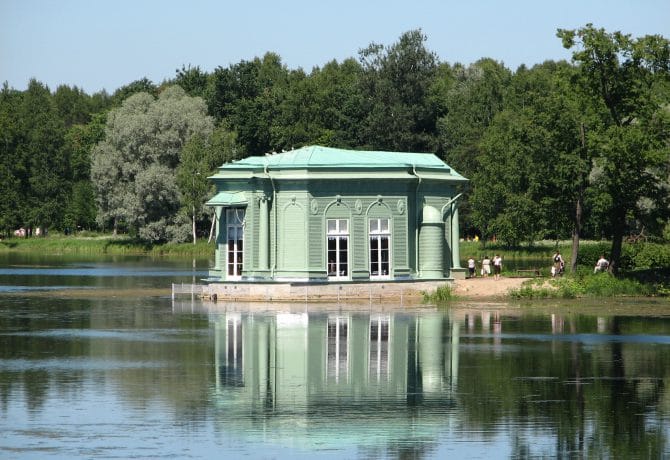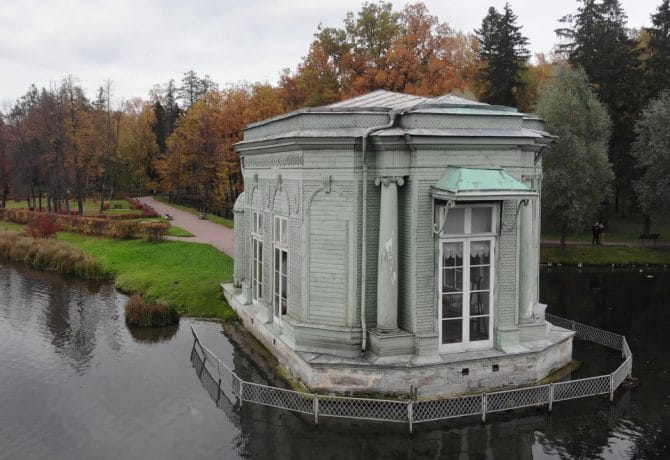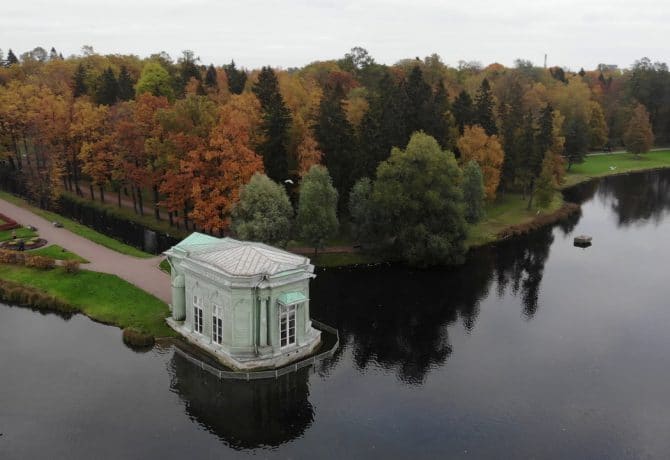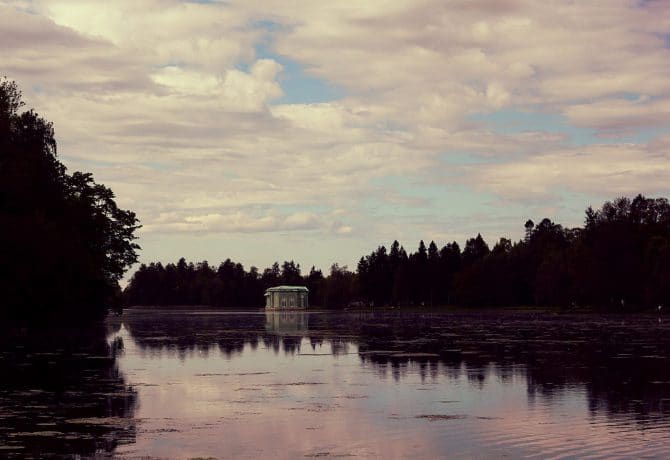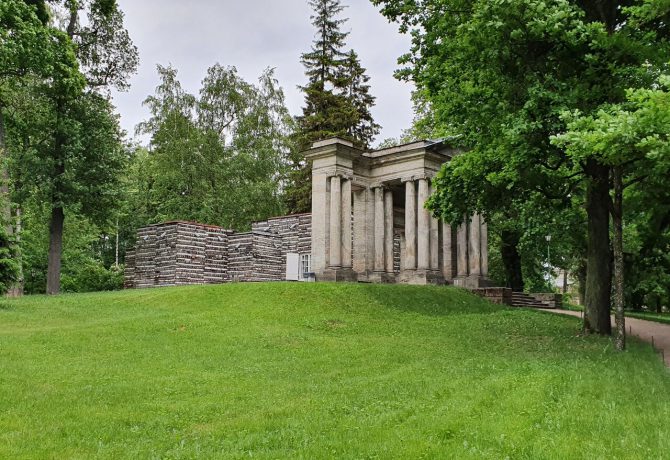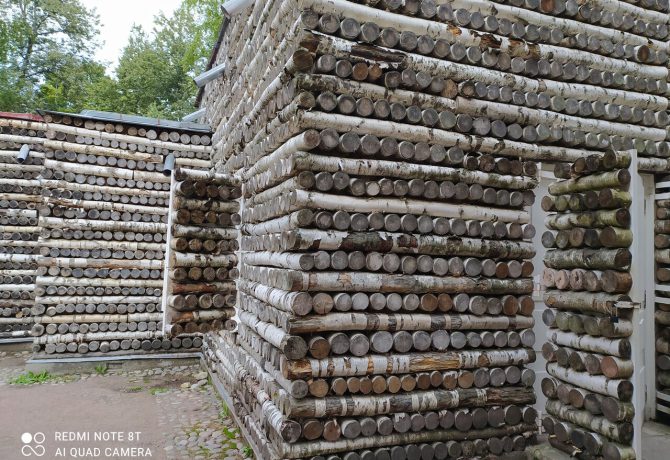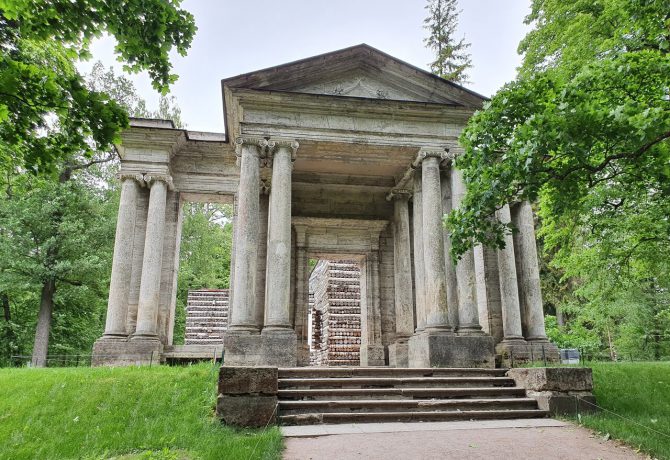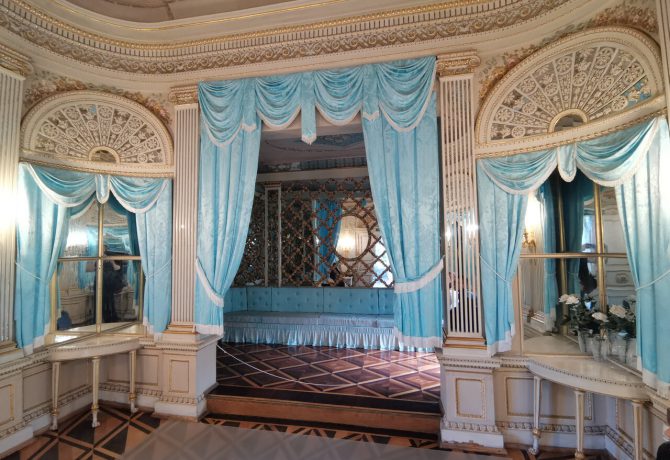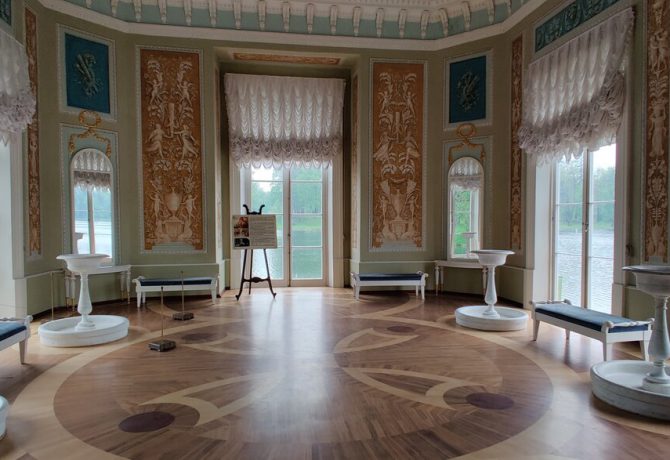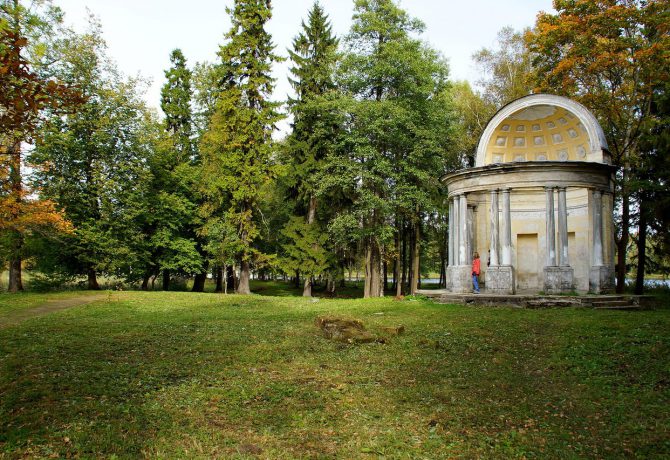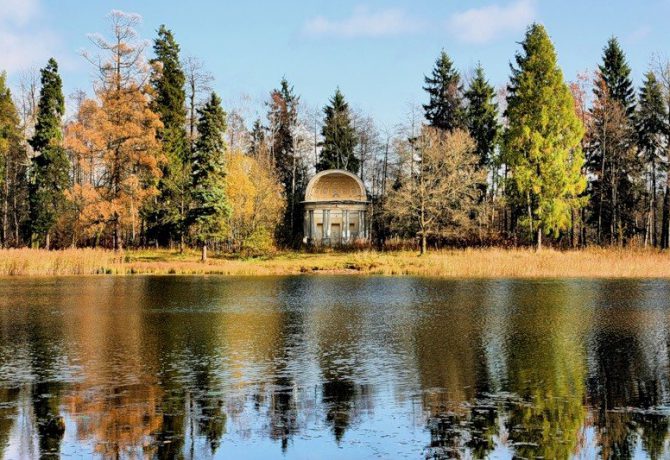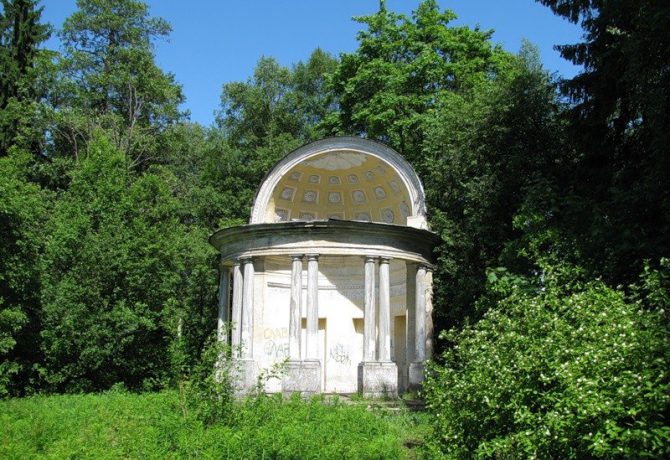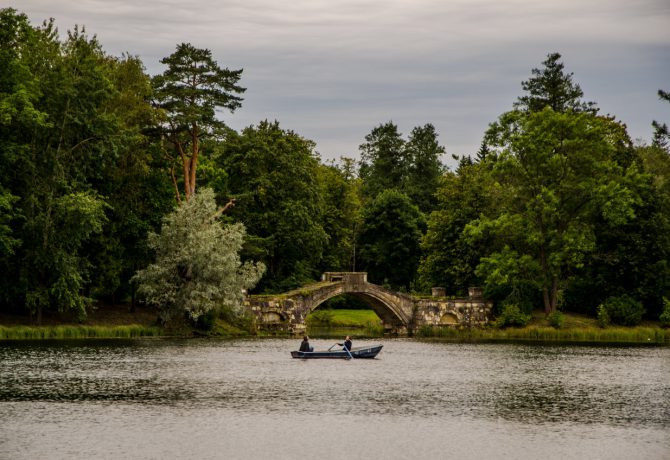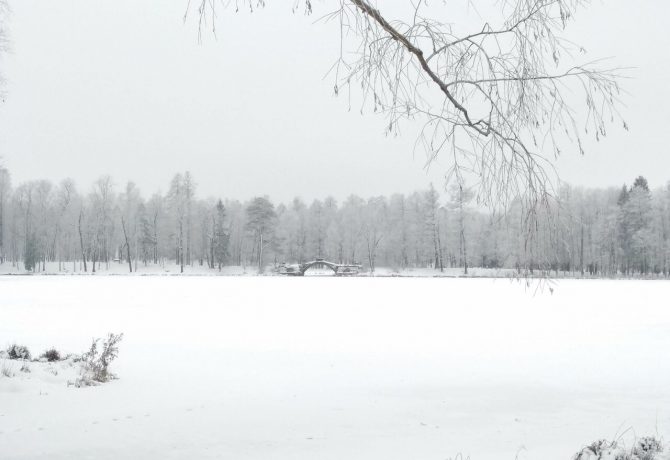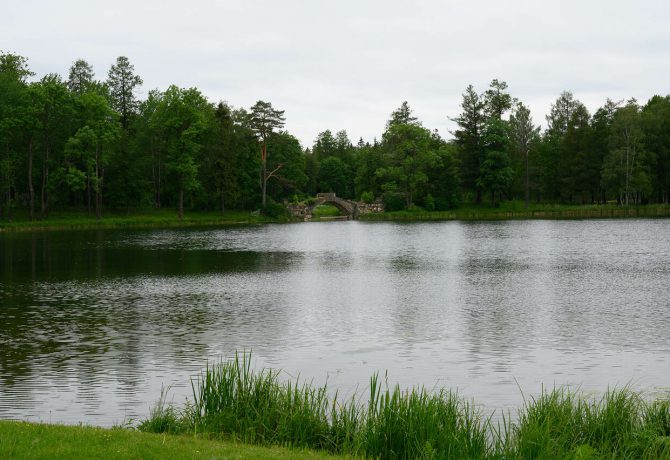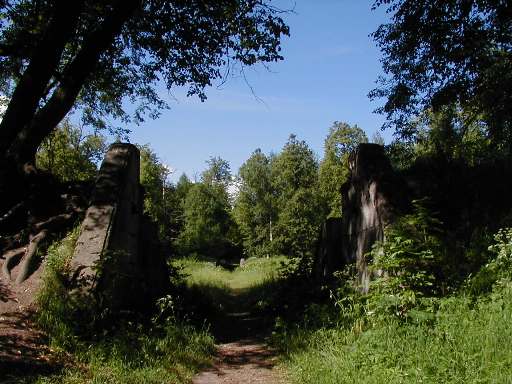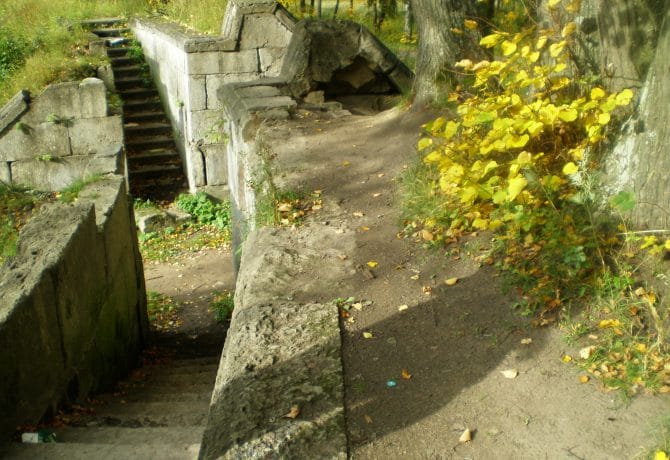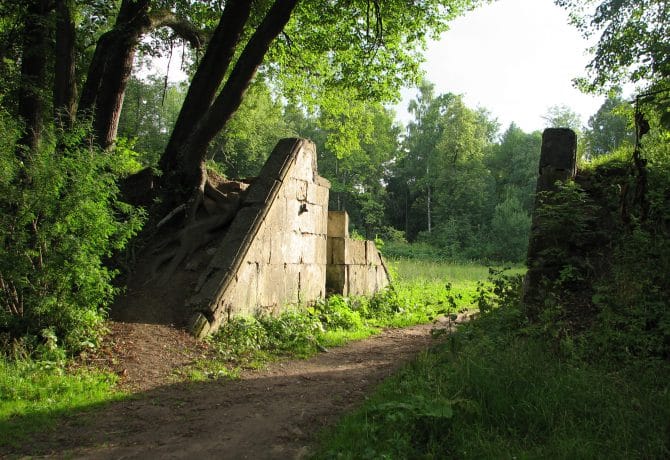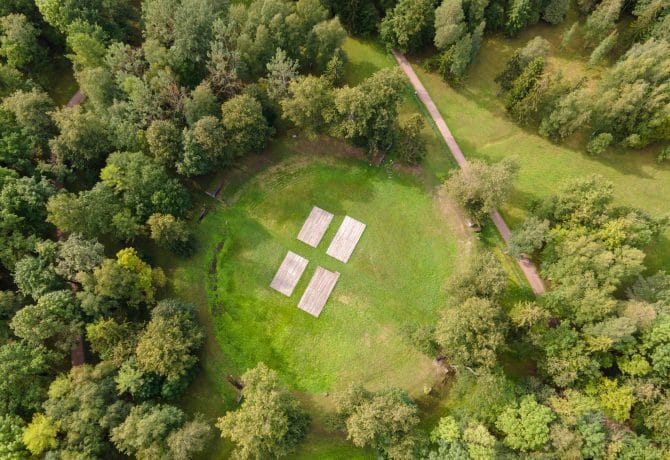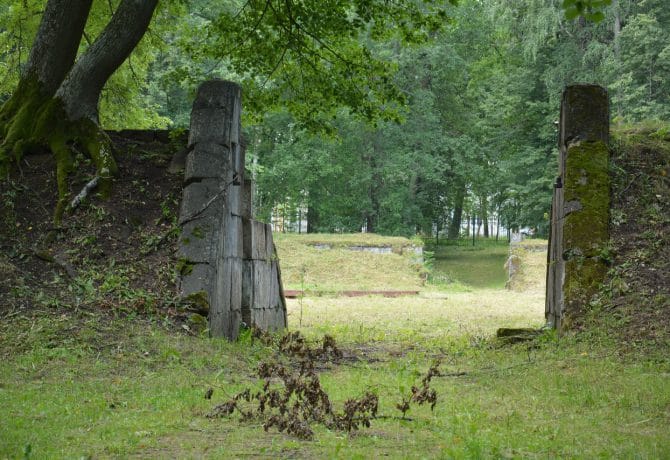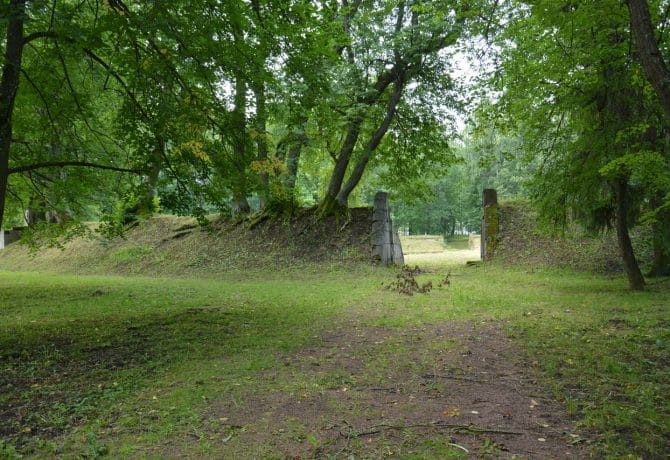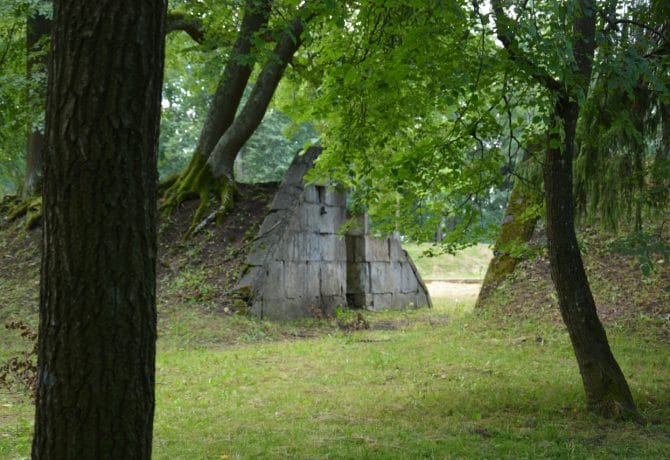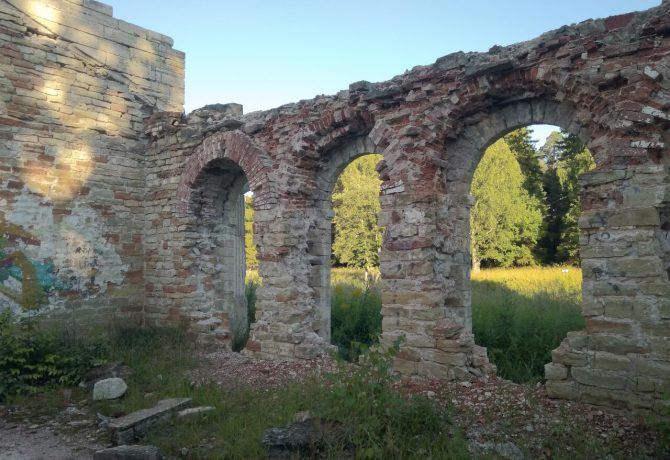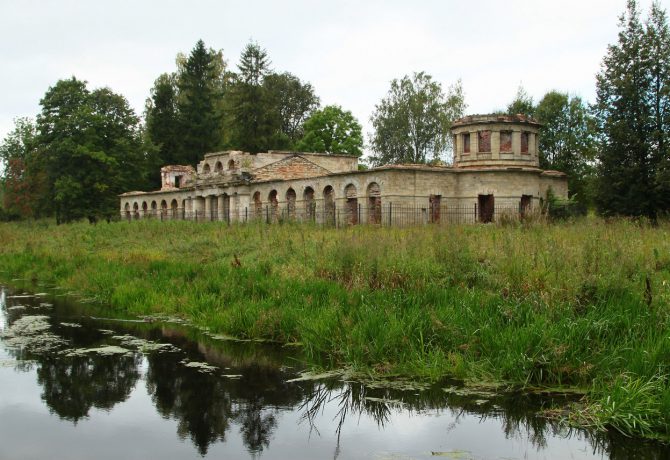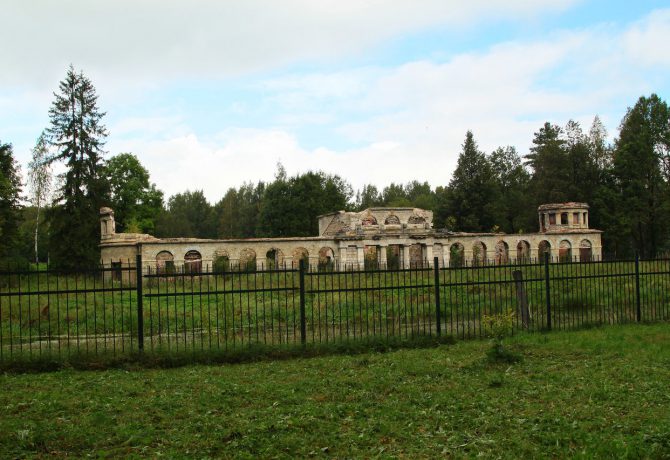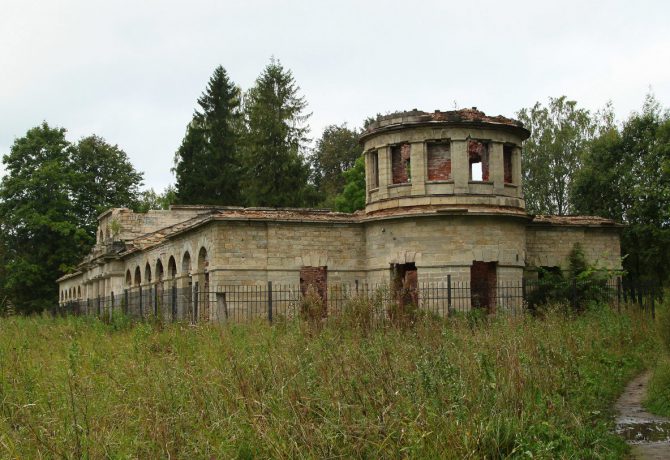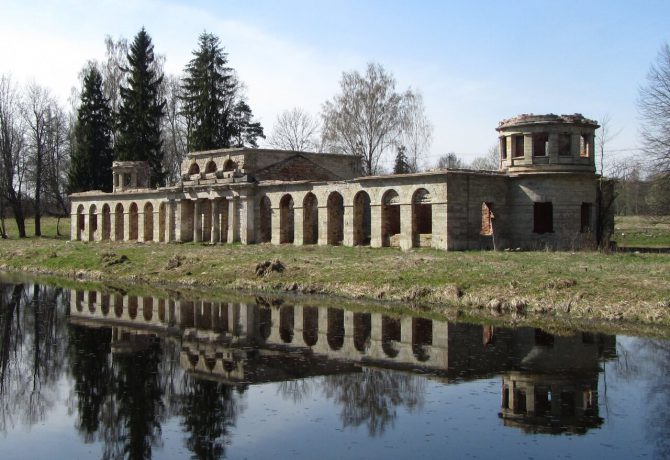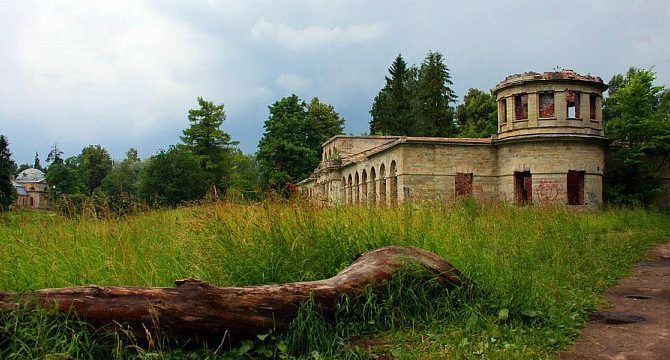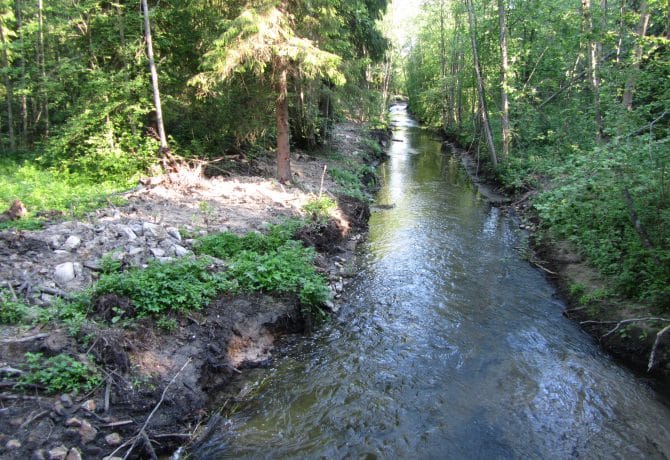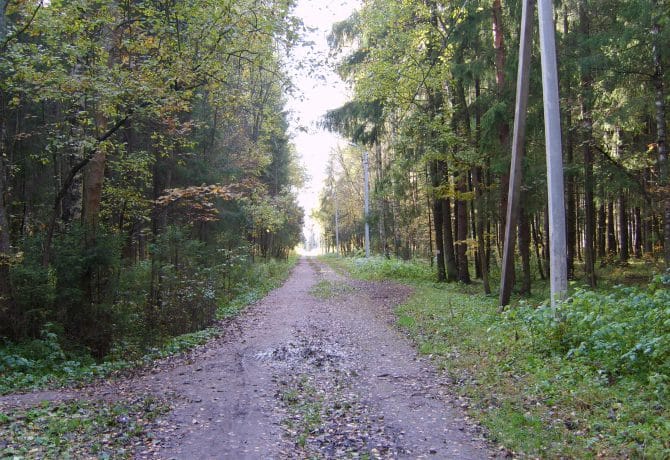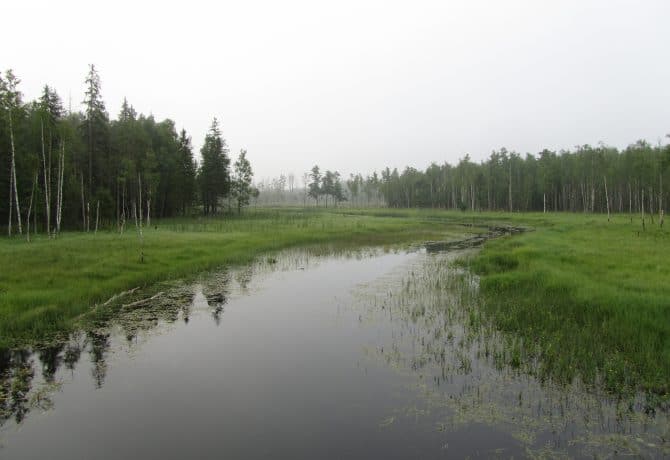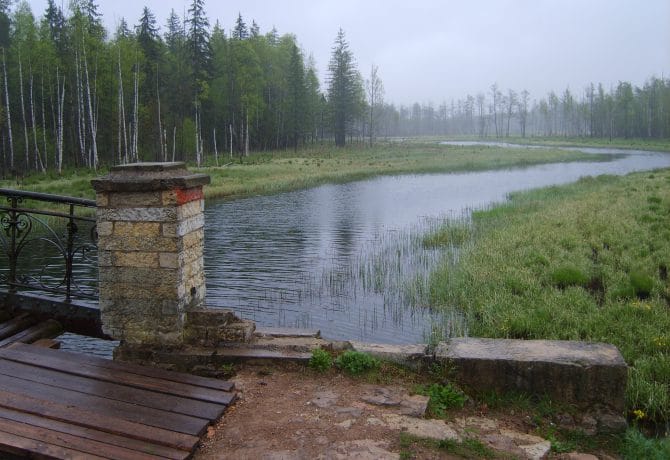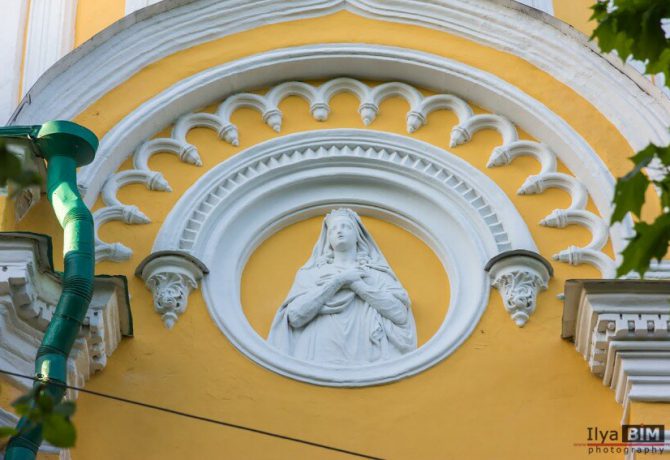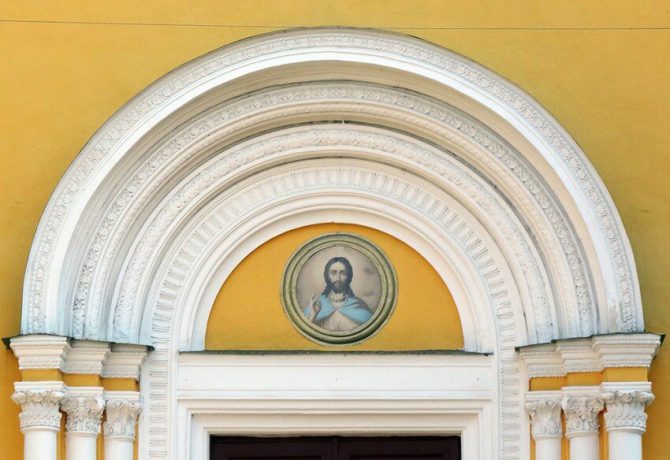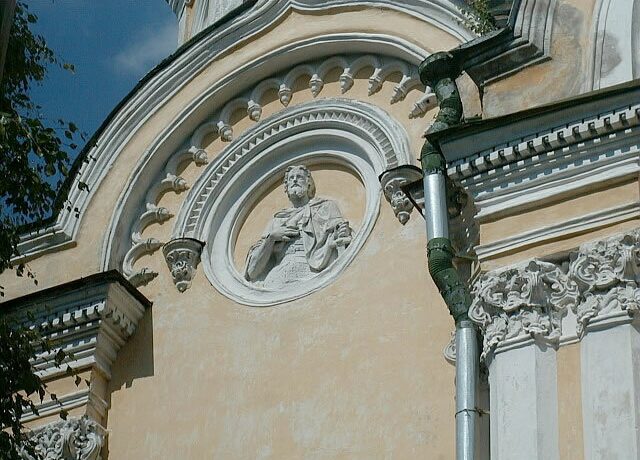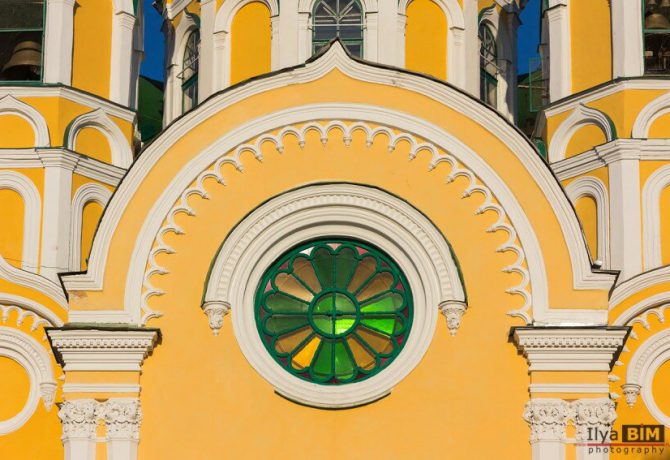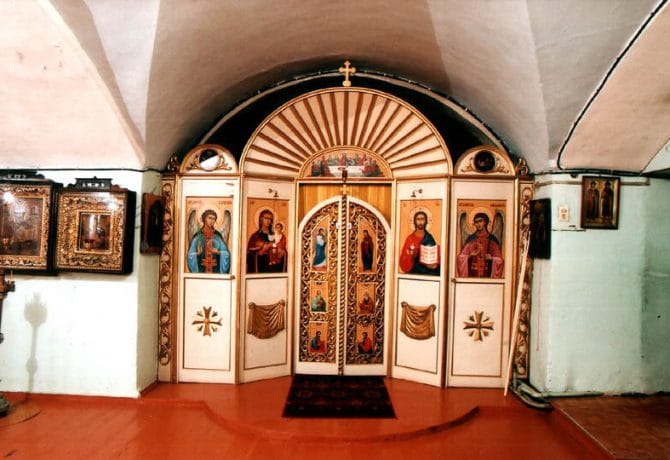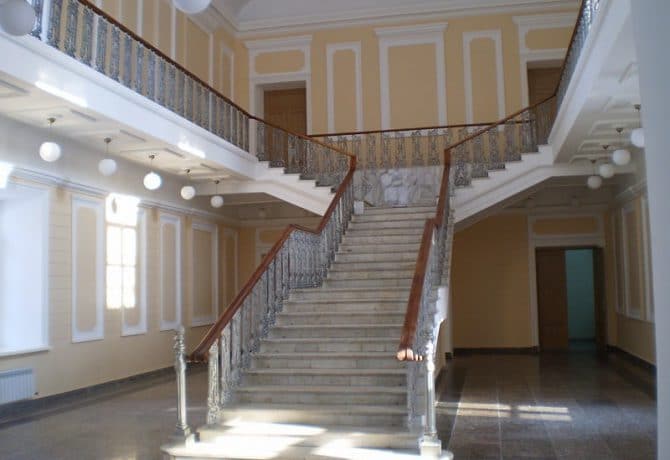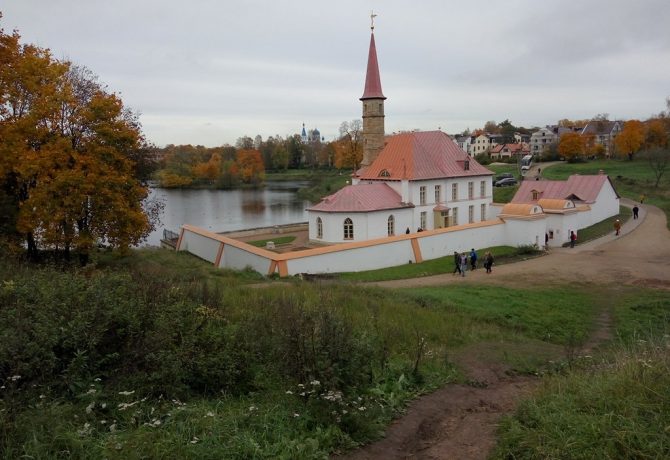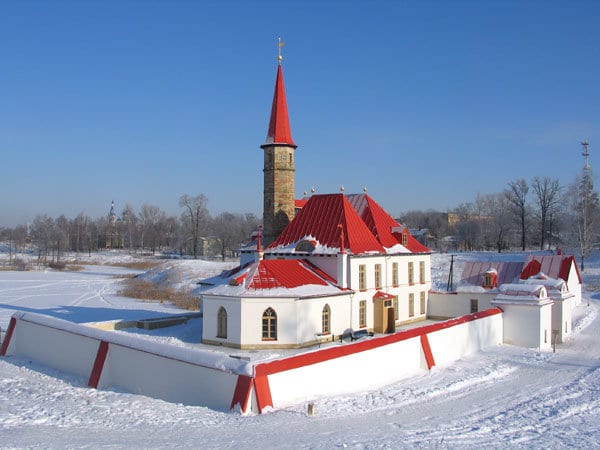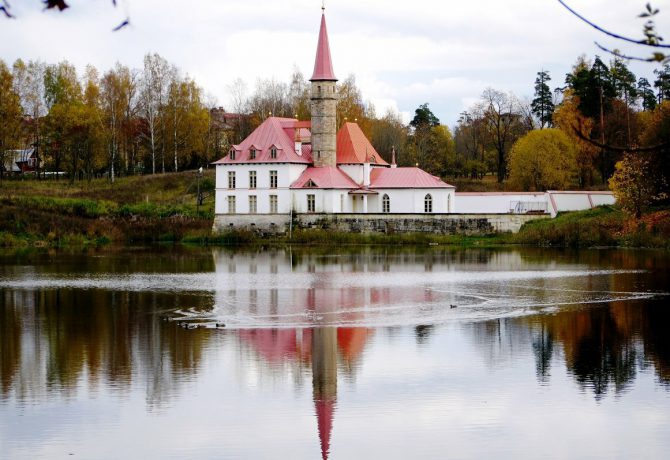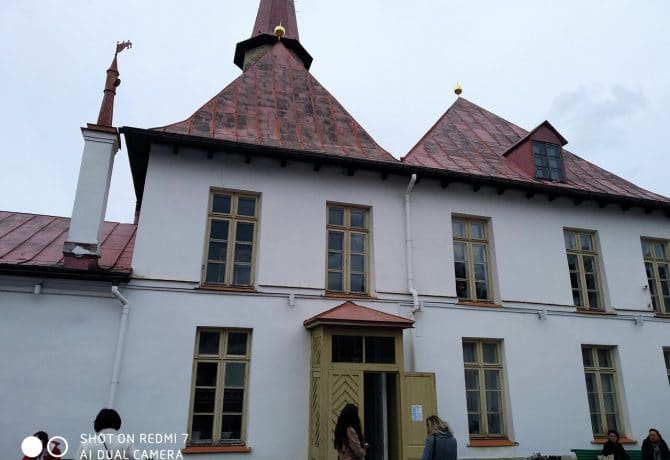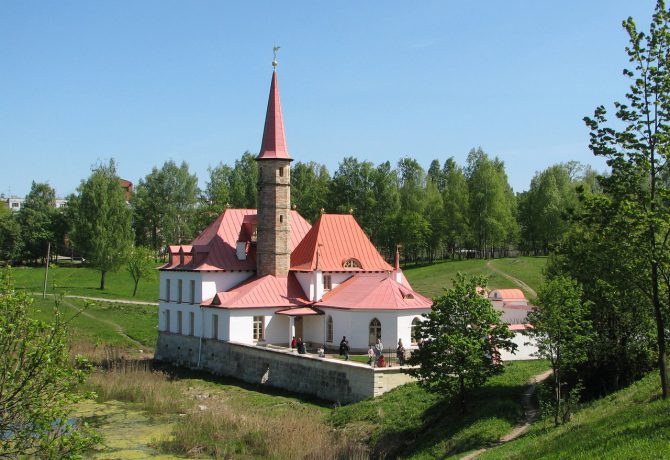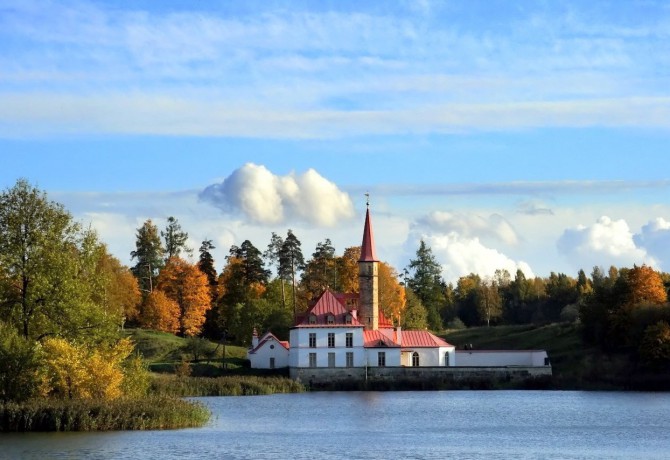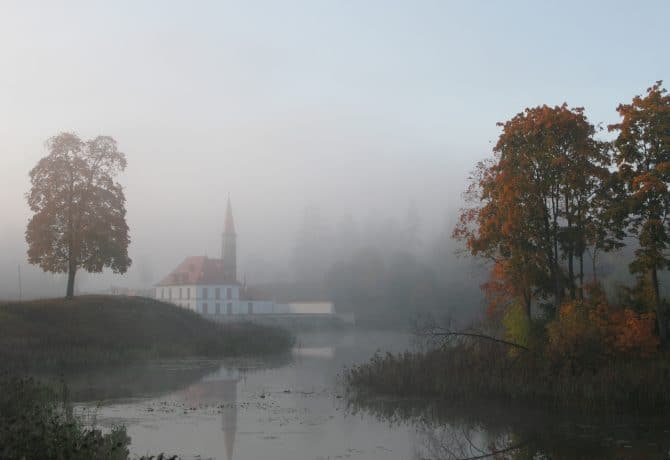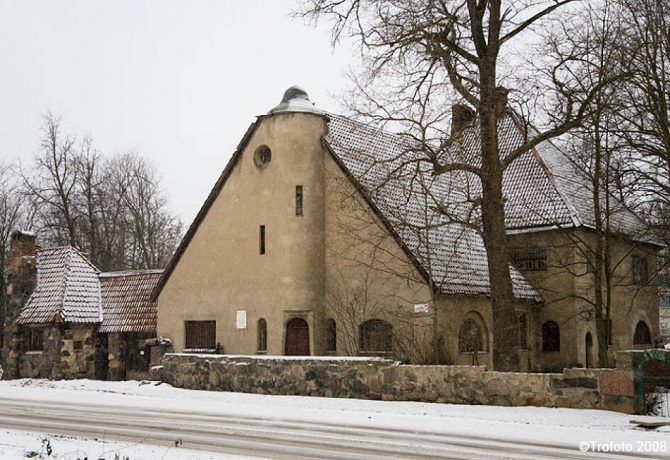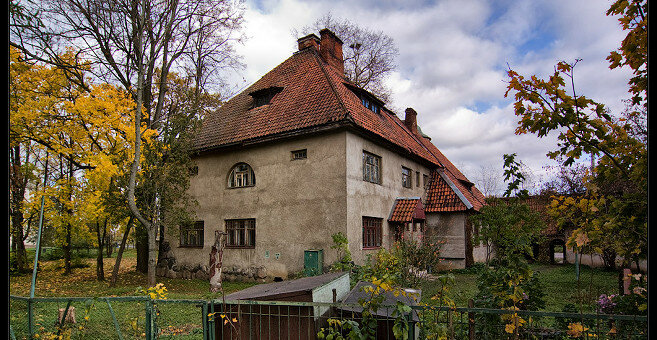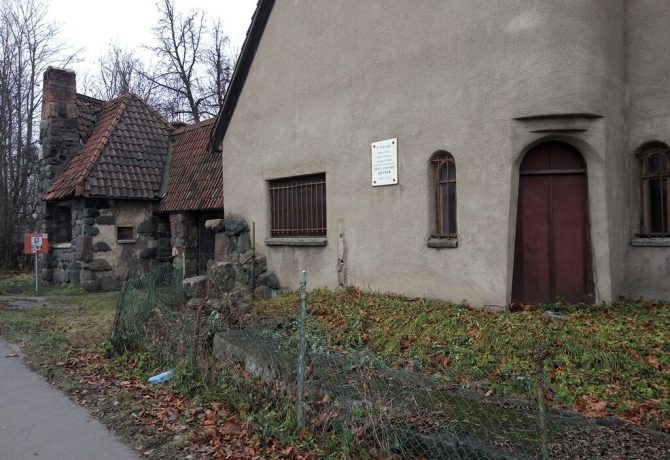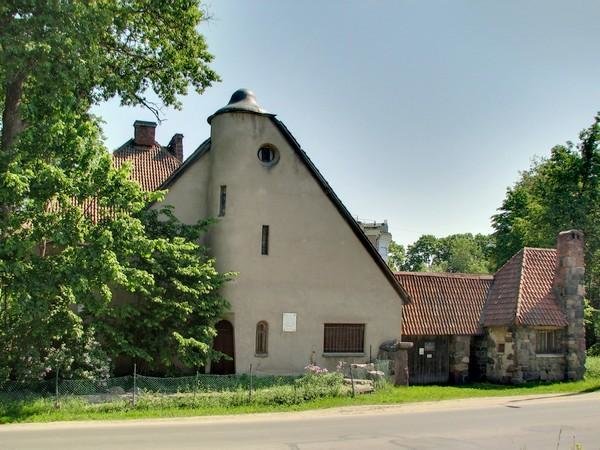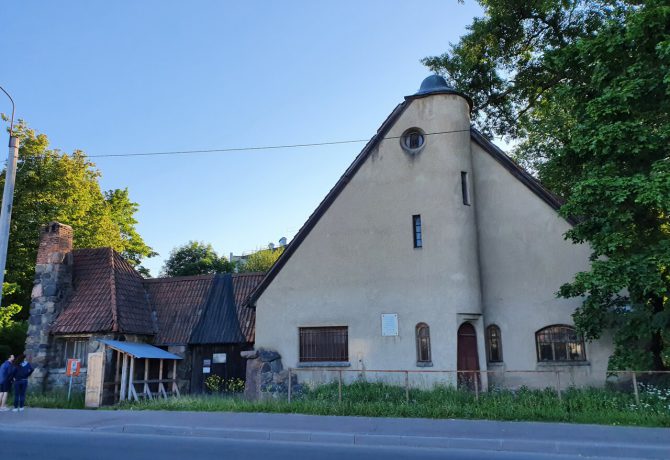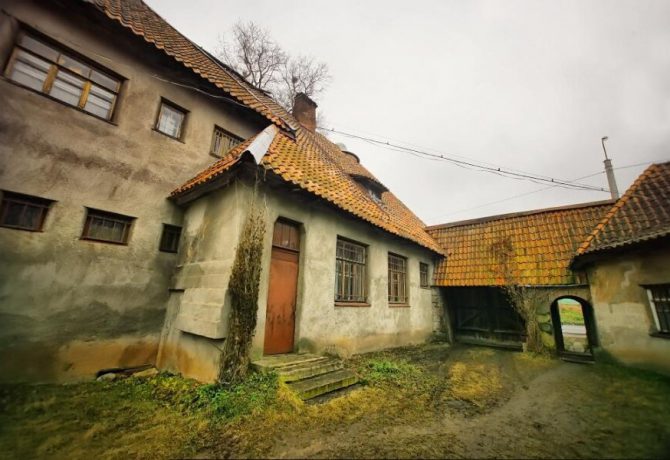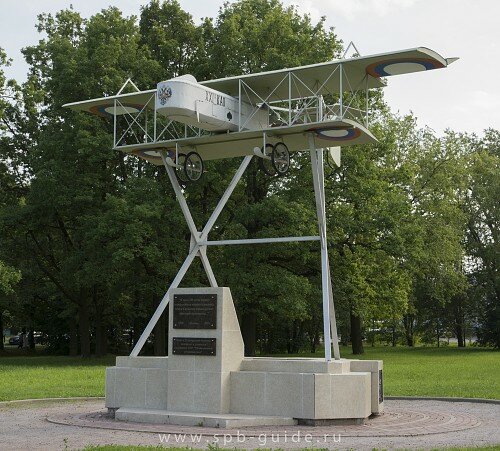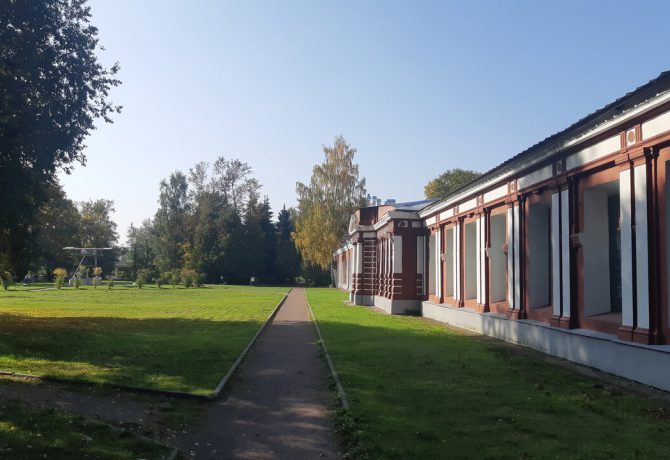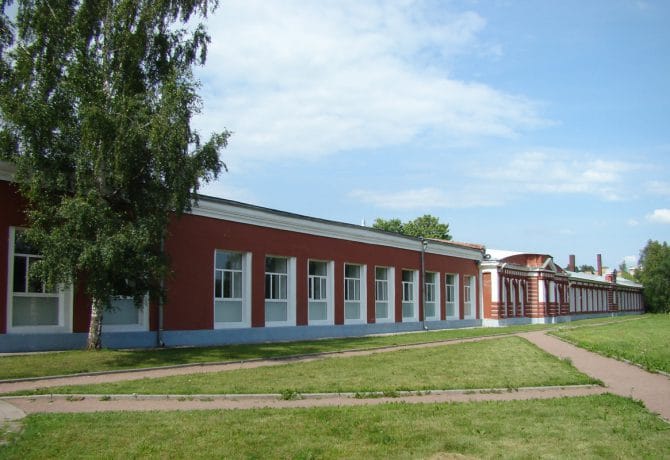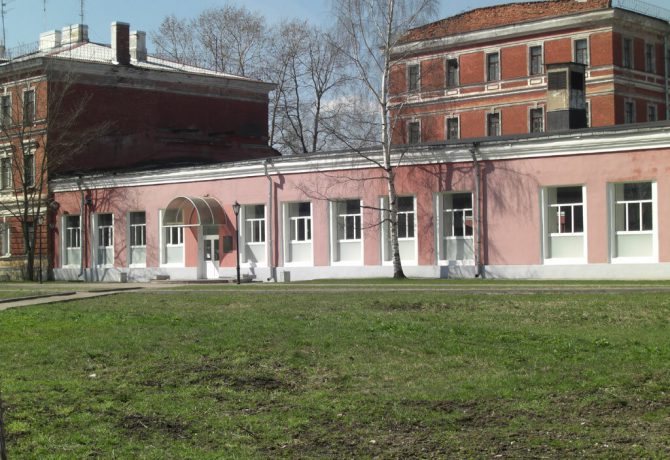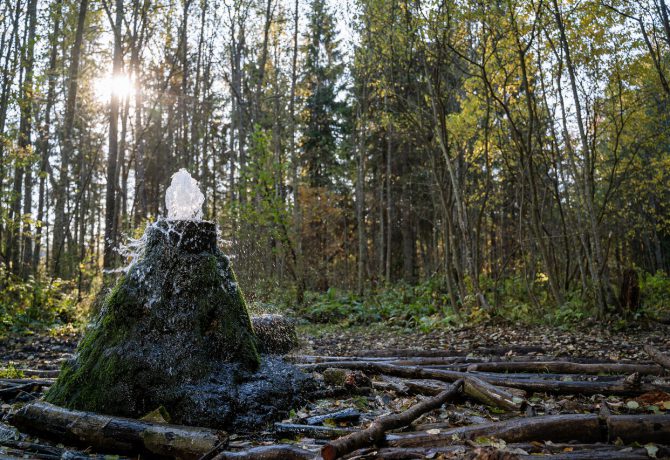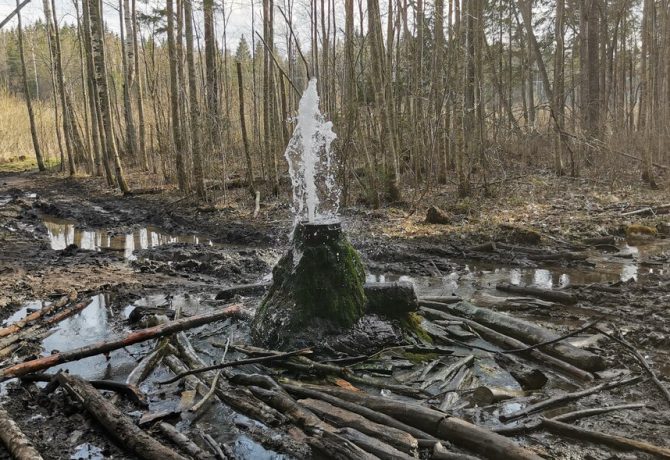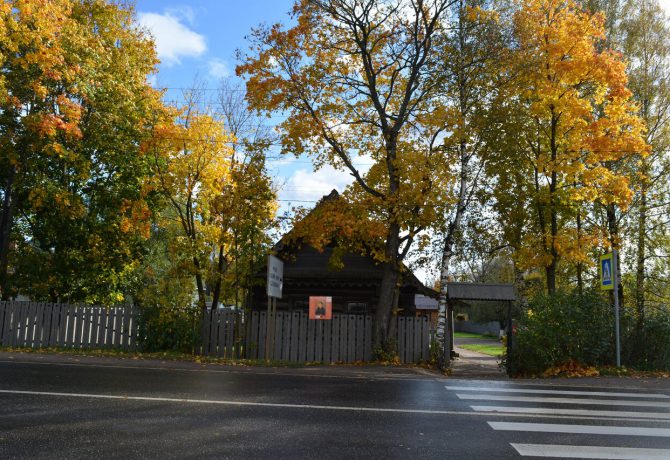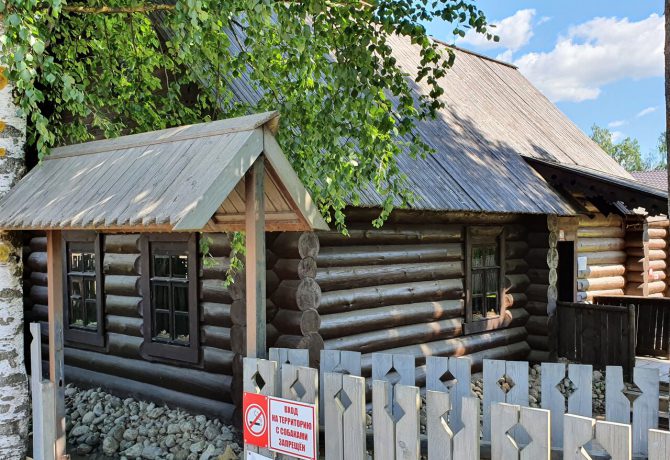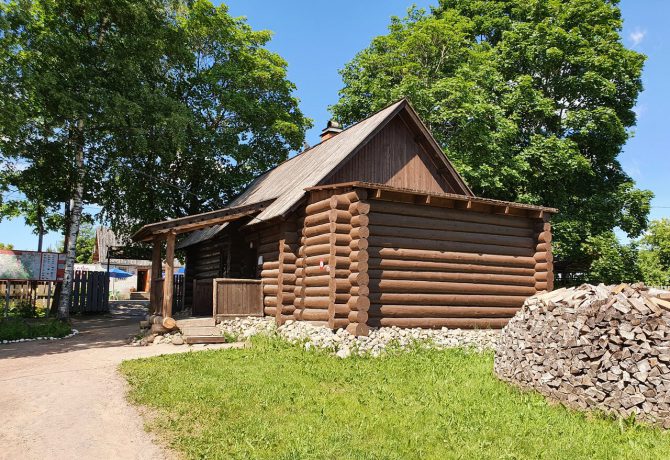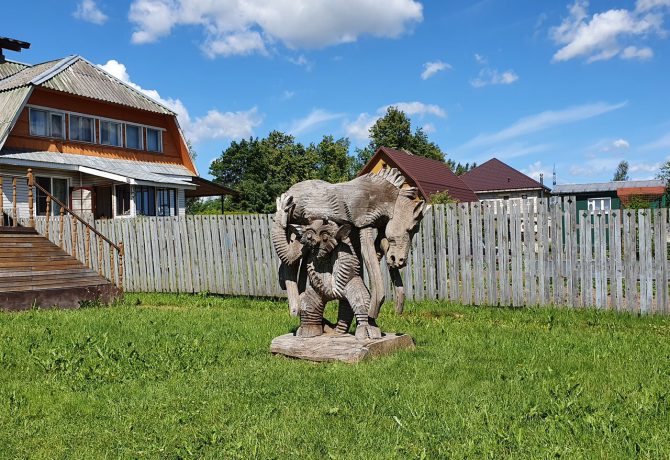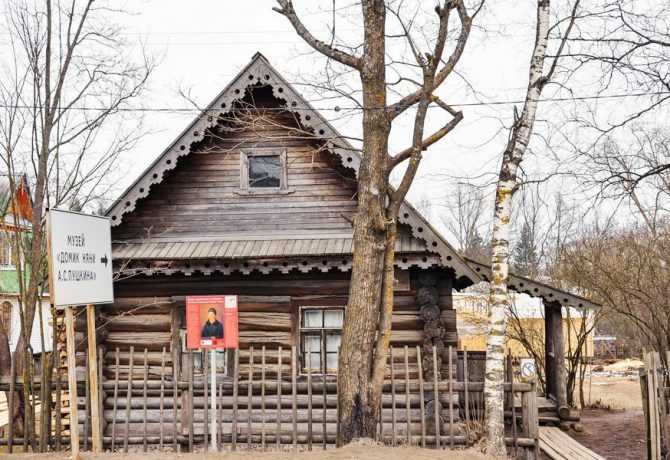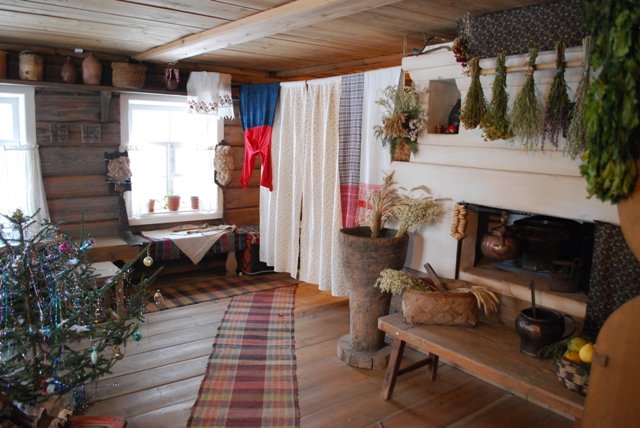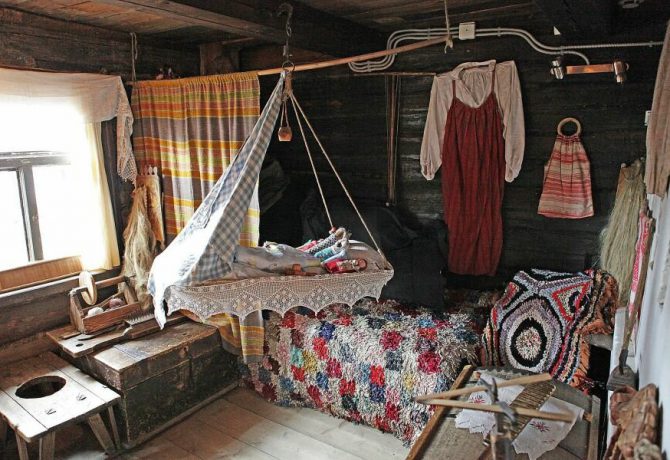Gatchina () is a city in Russia, the administrative center of Gatchina Municipal Formation of Leningrad Oblast. The city of Gatchina became famous for the fact that here in 1880 Dzhevetsky’s submarine was tested and became the first serial submarine in the world. But the main pride of the city of Gatchina is still a palace and park complex, which, together with the entire historical center of Gatchina, is included in the UNESCO World Cultural Heritage List.
- 1 Palace Park
- 2 Grand Gatchina Palace
- 3 Karpin Bridge
- 4 Water labyrinth
- 5 Venus Pavilion
- 6 Birch House
- 7 Eagle Pavilion
- 8 Humpback Bridge
- 9 Amphitheatre
- 10 Pavilion “Poultry House”
- 11 Menagerie Park
- 12 St. Paul’s Cathedral
- 13 Priorat Palace
- 14 Manor-museum of P. Shcherbov
- 15 Museum of Aircraft Engine Building
- 16 Gatchina geysers
- 17 Museum “House of the Nanny of A. S. Pushkin”
- 18 Attractions Gatchina on map
Palace Park
This large-format monument of Russian classicism of the XVIII-XIX centuries is included in the Gatchina Museum-Reserve. In suburban manor ensembles, much attention was always paid to green spaces: of course, it was also possible to build an elite structure in the capital, but it was hardly possible to create a large park there. The Palace Park in the city of Gatchina is a fine example of the consent of the man-made and natural forest in the North-West of Russia and the luxurious architecture of the middle of the XVIII-XIX centuries.
The palace park in the city of Gatchina was laid in 1765 by Count Grigory Orlov, to whom Catherine II presented the city of Gatchina. The project was prepared by the famous English gardener John Bush. On the site of the forest that grew around the White Lake, he planted rare plants and many species of trees. At the same time, the first monuments were erected. The grotto “Echo”, the Chesme obelisk and the column of the Eagle have survived to this day. The park was steadily landscaped until the assassination of Emperor Paul in 1801 – after that no large-scale work was carried out here.
Entrance to the park is free of charge with a QR code. Single tickets and passes for an unlimited number of visits can be issued in the terminals at the entrances and on the website of the museum-reserve.
There are 5 entrances to the park: near the Palace Farm, at the Birch Gate, at the Arsenal Square, at the printing house and from Nesterov Street. And on each side there are hotels of the city of Gatchina. In the event of a storm warning, the park may be closed.
Address: Gatchina city, Krasnoarmeysky Prospekt, 1.
Site: https://gatchinapalace.ru/park/attractions
Grand Gatchina Palace
Catherine II, throughout the history of the board, there were several favorites that replaced each other. In 1760 he was Count Orlov. The Great Empress expressed her own location with a present: a land plot near St. Petersburg on the coast of silver Lake. The talented architect of that period Antonio Rinaldi founded the palace and park complex. The construction of the Grand Palace took 16 years. But his story didn’t end there.
After the death of Orlov, Catherine bought this estate from the heirs and gave it to her son, the future Emperor Paul I. The new owner transformed the Gatchina Palace at will. Paul was a man who had many different fears and suspicions. Therefore, the Gatchina Palace with him began to resemble a military building.
Then the city of Gatchina was transferred from one ruler to another, until it was nationalized and transformed into a museum, which today can be visited by anyone. As you know, the fascist troops were stationed in the south of the city of Gatchina. During the retreat, the Gatchina Palace was set on fire and damaged inside. It was opened only in 1985, the restoring of some rooms is still ongoing at the expense of the museum’s personal money.
The Gatchina Palace was reconstructed inside and out, but the stone facing with Pudost stone has survived to this day. This is a unique porous, light and frost-resistant material that is mined in the Pudost River near the city of Gatchina.
The cost of visiting the permanent exhibitions of the Gatchina Palace:
- for adults – 450 rubles;
- pupils and students – 200 rubles;
- for persons over 65 years old – 250 rubles;
- for a family (2 adults with children) – 1100 rubles.
Address: Gatchina city, Krasnoarmeysky prospekt, d. 1.
Website: https://gatchinapalace.ru/gatchina
Karpin Bridge
In the 1790s, reconstruction began in the Palace Park: old wooden bridges were replaced with stone bridges. One of them was the Karpin Bridge, built across the canal connecting Lake White and the Karpin Reservoir.
In 1792, an architectural building was erected over an artificial dam and a cascade – a bridge that regulates the height of the water in the Karpin Pond. Karpin Bridge got its name from a nearby pond that was created to grow silver carp for the imperial table.
Vincenzo Brenn was one of the authors of the plan to build a single-span stone bridge covered with slabs of powdery limestone. According to the architect’s idea, the pillars of the bridge are made in the form of fortified towers with triangular ledges, on which stone benches are built. Light gray granite parapets are used as the railing of the bridge. Along the entire length of the bridge is a horizontal cornice, supported by 48 sculptural brackets, 24 from each edge. Karpin Bridge unites the two parts of the Long Island, through it there is an alley that begins with the loggia and ends in the north-western part of the island.
Due to the uncomplicated architectural solution, the Karpin Bridge forms a harmonious whole with a terrace on the embankment and the Humpback Bridge, effectively complementing the strict appearance of the Gatchina Palace.
Like many buildings located in the Palace Park, the bridge was almost completely destroyed by the retreating fascist troops. The creator of the restoration project was the architect Lev Noskov, work on the construction of the bridge was carried out under the control of engineer Andrei Sokolov. The bridge was completely renovated in the 1980s and is now open to the public.
Address: Gatchina city, Krasnoarmeysky prospect, 1
Water labyrinth
In the XVIII century in the parks of all cities it was very fashionable to build ground labyrinths. Such a structure could boast of many landscape gardens of Europe. However, there were no analogues of the Gatchina water labyrinth anywhere.
The relatively small labyrinth, which was created under Paul I, was an archipelago of artificial islands and canals between them at the White Lake. The shores of the labyrinth were strengthened, wooden bridges were built between the islands. In 1880, they were replaced by cast iron structures designed by military engineer Ludwig Schperer. These small bridges with openwork grids connect the islands and canals and give the lyrical landscapes of the city of Gatchina a special chamber sound.
The water attraction was designed in such a way that it was difficult for lovers of water walks to find an exit to the lake because of the deliberately intertwined system of labyrinths with its curves and dead ends. From May to October 2010, the restoration of the bridges of the water labyrinth was carried out by a company from St. Petersburg. Historic trails, reclaimed islands and canals have also been restored and modern hotels have been built nearby.
Address: Gatchina city, Krasnoarmeysky prospect, 1
Venus Pavilion
The idea of building a pavilion of Venus arose from the future Emperor Paul I after visiting France in 1780. After visiting the Chantilly Palace, he was impressed by the picturesque pavilion and wanted to build it in his residence near St. Petersburg.
Later, when the court architect of Paul I, Vincenzo Brenna, designed the Gatchina Pavilion, he used the image of the Chantilly building. The experienced architect did not completely copy the French pavilion. He simply realized the general idea of building a pavilion with one part on the shore, and the other on stilts above the lake. Guests on a boat sailed to the Pavilion of Venus and climbed the steps to the halls. The first of them, the lobby, had an oval shape, and the main hall was rectangular.
The one-story pavilion was badly damaged in the battles of the Great Patriotic War. During the artillery shelling, the walls and columns of the pavilion were disfigured, paintings, a picturesque ceiling and a floor were damaged.
The restoration of the old pavilion took place in the mid-1960s. Wall frescoes and painting of the ceiling of the pavilion were performed by the artist Alexander Mikhailovich Lyubimov. In the 1970s, the interior of the Venus Pavilion was rebuilt according to the project of architect and restorer Alexander Alexandrovich Kedrinsky; The last restoration of the pavilion took place in 2007-2010.
Address: Gatchina city, Krasnoarmeysky prospect, 1
Birch House
The birch house, designed by the Swiss artist and architect of the small courtyard François Viollier, was created in the mid-1780s and outwardly represented a small pile of birch firewood harvested for a long winter. It was a kind of joke, a pastoral whamma of the eighteenth century.
Behind the simple facades hid wealth and luxury. Paintings and gilded decorations, many mirrors gave the interior a special idle look. This contrast always amazed contemporaries, as the insignificant pavilion became a sudden surprise for visitors walking through the Gatchina Park.
In 1796, under the management of the architect Vincenzo Brenna, a grandiose portal “Mask” was created, which sheltered the Birch House.
In the second half of the 1790s, a stone gate appeared on the eastern outskirts of Palace Park, called the Berezovs, because they were not far from the Berezovs’ house.
Tourists in this place are accepted only in summer from 11:00 to 19:00 (ticket office until 18:00).
Address: Gatchina city, Krasnoarmeysky prospect, 1
Eagle Pavilion
The Eagle Pavilion was built in Gatchina Park at the end of the XVIII century. The exact date of construction of the pavilion is unknown: it is believed that the pavilion began to decorate the palace gardens in 1792, but some researchers claim that this happened in 1793-1796. The author of the pavilion is also not reliably established: neither the author’s drawings nor clarifying documents were found, but, probably, the pavilion was built by the architect Vincenzo Brenna.
The site for the pavilion was chosen at the end of the clearing, which stretches from the Eagle Column in the east to the Long Lake on white lake. For what reasons this place was chosen, why both pavilions are made in the same style and with the same sculptural decoration, for which an emphasized connection between these pavilions was built – there are no answers to these questions. However, this compositional unity created an interesting architectural ensemble.
On the shore of the White Lake in front of the Eagle Pavilion, a stone pier was built, which, unfortunately, has not been preserved.
The first name of the pavilion is most likely associated with the marble statue of the eagle, which used to stand on the entablaster above the central staircase. The head of the pavilion eagle was facing north and topped by an imperial column. In the claws of the bird was a shield with a monogram of Emperor Paul I.
The origin of the second name of the pavilion – Tempel – raises a number of questions. This name comes from the French word that means “temple”. However, when it was attributed to the pavilion and what this name is associated with, it is impossible to say unequivocally.
In 1846, almost half a century after the construction of the pavilion, Emperor Nicholas I by his decree renamed the Pavilion of the Eagle. In shape, the pavilion received a simple park name: a round gazebo.
During the war, the Eagle Pavilion was partially destroyed by a high-explosive bomb that exploded nearby. The shock wave damaged the pavilion and caused the collapse of part of the entablaturist and part of the dome. During the restoration of 1969-1972 according to the project of A. Naumov, the Pavilion of the Eagle was restored.
Address: Gatchina city, Krasnoarmeysky prospect, 1
Humpback Bridge
The Humpback Bridge passes through the Long Island and connects White Lake and Silver Lake. The author of this romantic structure, the Humpback Bridge, was the architect A. D. Zakharov. Permission to work with the bridge was obtained in November 1800. The master found the right balance between the size of the Brokeback Bridge, the decorative design and the surrounding landscape.
The humpback bridge consists of 3 parts. Each of them is created as a panoramic platform of the bridge, from which the surrounding view is perceived differently, this is the peculiarity of the Brokeback Bridge. Previously, the terraces and span of the Brokeback Bridge were dotted with balustrades. A wide staircase could be climbed from the shore to the platforms of the Brokeback Bridge. Steeper flights of stairs led to the upper observation deck of the bridge.
Another uniqueness of the Brokeback Bridge is that it passes through a water strip 25 meters wide, which not only connects the two parts of the water, but also such attractions as the “Pavilion of the Eagle” and the “Big Pier”.
Almost all bridges were destroyed during the war. Miraculously, the Brokeback Bridge was not damaged, but the benches and part of the balustrade were destroyed. The restoration of the Brokeback Bridge was carried out in 1969 and 1980. Over time, the Humpback Bridge again acquired a dilapidated appearance, but did not lose its charm.
Address: Gatchina city, Krasnoarmeysky prospect, 1
Amphitheatre
The end of the 18th century was the heyday of European park art. Almost an indispensable attribute of the green islands of that time were pseudo-ruins, pavilions, improvised fortress houses and amphitheaters. The latter was also built in 1797 by architect Nikolai Lvov in the Palace Park of the city of Gatchina next to the Eagle Column and the Great Greenhouses.
The pavilion “Amphitheater” was built for the entertainment of Paul I: the emperor loved grandiose theatrical productions imitating jousting tournaments. Two venues were for spectators, two more for knights. Eight stone staircases led to the top of the pavilion wall. Initially, the arena of the pavilion was planned to be decorated with incense bowls, and the stairs with eight gilded vases.
The amphitheater in the city of Gatchina is a round pavilion with a diameter of 65 m, surrounded by an impressive earthen rampart – it is both a wall and a platform for spectators. In it, through the same distance, 4 openings are cut, the ends of which are reinforced with strong blocks of Pudost stone of beige color. The once large structure now lies in ruins – the last time the pavilion was repaired in 1847-1849.
Address: Gatchina city, Krasnoarmeysky prospect, 1
Pavilion “Poultry House”
At the turn of the XVIII-XIX centuries on the territory of the estate of Count Grigory Orlov in the city of Gatchina, on the site of cattle and bird yards, new pavilions were built, called the pavilion “Palace” (“Milk”) and the pavilion “Poultry House”. These pavilions have become real architectural masterpieces that have survived to this day.
The construction of the pavilion “Poultry House” began in 1798 according to the project of architect A. D. Zakharov. The pavilion was designed to accommodate several species of birds: turkeys, pheasants, geese, canaries and even peacocks. The second name of the pavilion is “Pheasantia”. The pavilion had a U-shaped plan with a two-story central section and low side extensions. Small round turrets adorned the edges of the pavilion. Arched windows, which simultaneously served as portals, decorated the main facade from the side of Kolpanka, and from the large balcony of the pavilion there was a beautiful view of the estate.
For two centuries, the elegant design of the pavilion “Poultry House” amazed visitors to the estate and the museum created later. The picturesque pavilion of light stone was a real pearl of romantic landscapes of the winding Kolpanka River. Now the unique structure appears in a ruined state, and every year the pavilion becomes a platform for the reconstruction of historical battles.
Address: Gatchina city, Krasnoarmeysky prospect, 1
Menagerie Park
In the organization of the park “Menagerie” participated Grigory Orlov himself. He cleared the forest for fences and driveways, hunted and received guests in the park. Often visited him and the Empress herself, who loved to participate in falconry. After the death of Orlov, Paul I also actively designed the park “Menagerie” and even brought exotic camels there.
The design of the park with the division into vertical glades began in 1796 according to the project of the Irishman James Hackett, a gardener of the English landscape school. Later, in addition to birches, spruces and aspens, more than 30,000 lindens were planted in the park. Soon, a plot for deer, elk and deer was fenced off, where they could hide from predators invading the park. Also in the park were arranged ponds for drinking bowls and created stocks of hay and oats, so that the animals did not starve.
Seven wooden bridges, including a lift bridge, were built in Menagerie Park in the 1840s. In the same period, a flowing lake with an area of 14 thousand square meters appeared in the bed of Gatchinka. In 1858, the Imperial Hunt was finally moved from Peterhof to the city of Gatchina, which made it possible to turn the Menagerie Park into the hunting capital of Russia. In those days, the park was home to bison, roe deer, bears, rabbits, pheasants, partridges, wild boars, deer and so on. Also in the park was organized a small zoo.
Under Alexander II, the bridges in the park were strengthened with metal structures, an 8 km long fence was erected, and the number of animals was significantly increased. Also drained part of the park area for oats, clover and vegetables to feed all the animals. After the death of the emperor in 1881, the menagerie park was transferred to the Jägermeister, and after the coup in February 1917 and the extermination of almost all animals, with the exception of a small herd of bison, was open to the public.
During the occupation of the city of Gatchina in 1941/44, the nearest bridges to the city of Gatchina were blown up. In the late 1970s, the menagerie Park fell into decay, the forest began to waterlog, the cast-iron fences of the already destroyed bridges disappeared without a trace, the trees were cut down, and the glades were simply flooded with vegetation. In the late 80s, there were only a few attempts to organize restoration work of the park, for which it was necessary to find sponsors. Currently, the process of transferring the park “Menagerie” from federal ownership to the permanent use of the State Museum-Reserve “Gatchina” is underway.
Address: Gatchina city, Krasnoarmeysky prospect, 1
St. Paul’s Cathedral
The place for the cathedral church named after St. Paul, the so-called patron and founder of the city of Gatchina, was indicated personally by Tsar Nikolai Pavlovich. Pavlovsk Cathedral was founded on October 30, 1846 (architect R. I. Kuzmin). The cathedral was consecrated on July 12, 1852 by Metropolitan Nicanor (Klementievsky).
Before the war, the local authorities decided to build a three-story cinema on the territory of the cathedral. But the money for the new building did not arrive immediately and did not have time to disassemble the domes of the cathedral – the war came. The reconstruction of the cathedral began in May 1941, with the outbreak of war all work was stopped, so that the cathedral remained more or less the same. But during the offensive of the German Wehrmacht, our troops in the cathedral equipped a sniper position as at the highest point of the city: cracks were drilled in the altar of the cathedral.
When the bombing began, the structure of the cathedral was badly damaged, and the dome was piercled by a shell.
The city of Gatchina was conquered by the Germans in early September 1941. Local residents feared the worst, but, to the surprise of believers, the German authorities offered to open one of the churches. The Germans chose the Intercession Cathedral, but the faithful, led by the abbot, asked to open the Pavlovsk Cathedral, stressing that this is the main temple of the city of Gatchina.
In January 1944, the city of Gatchina was liberated by Soviet troops, and the Pavlovsk Cathedral was recorded as “active”. Immediately after the war, the restoration of the cathedral was carried out, as a result of which it was restored almost to its original appearance.
St. Paul’s Cathedral is open daily from 8:30 to 20:00. Liturgies in the cathedral are usually celebrated on weekdays at 9:00, on Sundays and holidays at 7:00 and 9:40. Church services are held daily in the cathedral. Every Wednesday at 17:00 at St. Nicholas the Wonderworker a moleben with an akathist is held. Every Friday at 17:00 a prayer service is held with the akathist to the great martyr and healer Panteleimon. Every Sunday in the cathedral after the late liturgy, a moleben is performed in honor of the holy martyr Mary of Gatchina. The priest on duty in the temple is from 9:00 to 17:00 every day.
Address: Gatchina city, Soborna str., 26
Priorat Palace
The chronicle of the Priorat Palace is closely connected with the history of Russia at the end of the XVIII century. In 1797, a suitable situation was formed for Russia’s rapprochement with the Order of Malta. In January 1797, Paul signed the Convention, according to which the Catholic Grand Priorate of Russia of the Order of Malta was established on Polish territory, not so long ago annexed to Russia. To accommodate the administration, the order was allocated the former Vorontsov Palace in St. Petersburg. At the same time, it was decided to create a suburban palace in the city of Gatchina for a Maltese monastery.
The name Priory is a modified word “priory”, translated into Russian: this has long been the name of small monasteries and monastic possessions in Western Europe.
The creator of the monastery was Nikolai Alexandrovich Lvov, who entered the history of Russian art not only as an architect. Among his friends, he was known as a writer, playwright, artist and as a person interested in various technical innovations.
On the basis of the order, Lviv built a whole architectural complex, which is located on a massive terrace and resembles a temple, whose large four-pitched roofs, a tower with a spire and one-story additions with Gothic windows create the impression of Catholic antiquity. On the side of the chapel is a miniature garden, which was once decorated with two marble sculptures of Jupiter and Ceres, allegorically united with the personality of the ruler himself (Jupiter personified the highest power, Ceres – abundance). The courtyard can be accessed through the gate between the two gatehouses. Nearby are the best hotels in Gatchina.
Address: Gatchina city, Chkalov str., 22
Manor-museum of P. Shcherbov
Museum of P. E. Shcherbova is one of the oldest museums in the Leningrad region. The museum was opened in 1967 on behalf of the regional department of culture and was originally located in the building of the Priory Palace.
Pavel Egorovich Shcherbov was the first cartoonist whose magazine drawings were exhibited at art exhibitions. In his works P. E. Shcherbov used the latest achievements of printing technology. In 1908, the most notable work of the artist “Bazaar of the twentieth century” appeared at the exhibition of watercolors in St. Petersburg. Cartoons of P. E. Shcherbov was especially appreciated by A. Benois, V. V. Stasov, I. E. Repin, V. A. Serov.
Since December 1911, Shcherbov lived in the city of Gatchina in his new estate, built in the style of Northern Art Nouveau according to the project and under the guidance of the famous Russian architect Stepan Samoilovich Krichinsky. Many outstanding figures of Russian culture stayed here: singers, poets, writers, artists. After the October Revolution, the house was left to the artist at the request of Maxim Gorky. From 1919, Shcherbov worked as an assistant to the keeper of the Gatchina Palace until his death in January 1938.
Anastasia Davydovna Shcherbova, the artist’s widow, for many years created a museum in the estate, but only after 40 years she managed to do it.
Currently in the estate-museum of P. E. Shcherbova hosts a memorable exhibition dedicated to his life and work. There is an artist’s office, a kindergarten, materials about the family, friends of the artist. This bizarre museum, reminiscent of the fabulous gingerbread house of the Brothers Grimm, also hosts the exhibitions “History of the city of Gatchina at the beginning of the twentieth century” and “History of aviation in Russia”.
Address: Gatchina city, Chekhov street, 4
Museum of Aircraft Engine Building
A unique museum, analogues of which are difficult to find not only in Russia but also abroad, is dedicated to the construction and repair of domestic aircraft engines. The museum was created by the 218 ARP team to display information about the results of the construction and repair of the engine. Currently, the museum presents aircraft engines of 7 design bureaus – developers (manufacturers).
Next to each model in the museum there are information panels telling about the history of the engine, the design bureau, the manufacturer, the repair shop, the biographies of the main designers and the aircraft on which these engines were installed.
Address: Gatchina city, Grigorina street, 7A
Next are the sights in the vicinity of the city of Gatchina. It is better to book hotels nearby in advance to enjoy these places.
Gatchina geysers
Rarely does anyone know about the existence of geysers in the Leningrad region. They are located near the city of Gatchina, not far from the village of Korpikovo. Six Sources is a sight that will never be forgotten. Especially in winter, when each ejection from a meter to one and a half meters high leaves an ice dome.
Until now, no one knows why geysers appeared here. There are two positions on this. The first says that the reason lies in the 1980s, when additional sources of water were searched on the Izhora plateau. Many new wells were drilled, which were soon clogged with plugs due to the rapid curtailment of a hopeless project. Some technological features turned ordinary wells into geysers of the city of Gatchina.
The second reason is that geysers are a side effect of the project related to the creation of gas reserves in aquifers. The pressure in the underground water bubble is so great that the water fountain rises to the surface.
No matter how the Gatchina geysers are formed, now everyone can find the village of Korpikovo and admire this mysterious natural phenomenon.
Address: Gatchina city, Korpikovo village, 1
Museum “House of the Nanny of A. S. Pushkin”
The museum “House of nanny A. Pushkin” is located in the village of Kobrino, Gatchina district. Here Arina Rodionovna did not live long with her husband. After the birth of four children, she moved to Moscow to babysit the young poet, but often visited these places. Her descendants lived in the same hut.
Unfortunately, the house in which Pushkin’s nanny lived has not been preserved, but the hut of her relatives has been preserved, where in 1974 the museum was built. The museum has been preserved almost in its original form for two centuries. The walls and six crowns around the perimeter of the museum remained unchanged. The ceiling, roof and floor were renovated in two restorations. Around the museum there is still a garden with a well.
The museum recreates the life of a peasant family of the late XVIII – early XX century. In the middle red corner there is an icon with a lamp. On the Russian stove, which occupies a central place in the museum, there are clay pots and other utensils. On the ceiling – dried herbs and juniper, in the middle – a wooden table and benches, in the corners – a cradle, a chest with things, a spinning wheel. From the clothes you can see the festive clothes of a peasant woman – a summer dress and jackets. According to local residents, among the exhibits of the museum there is only one personal thing from Arina Rodionovna – a linen torba.
Address: Gatchina city, Kobrino village, 27
Attractions in Gatchina are now popular among Russian and foreign tourists. All the most interesting things in the city of Gatchina can be seen in 1-2 days, so it is better to book hotels in advance. The best time to travel is summer and golden autumn.

